Exploring the Flatlands
Add more detail about this feature, such as benefits or value
Add more detail about this feature, such as benefits or value
Add more detail about this feature, such as benefits or value
Add more detail about this feature, such as benefits or value
If you have a body of wild water near you like a pond, river, stream or lake you are bound to find them teeming with life. From fish, tadpoles and water insects to all types of interesting aquatic animals like newts, frogs and dragonfly nymphs. There will also be lots of other wonderful wildlife and birds in or around the water that you can look out for.
Safety note: Children should be supervised at all times around open water. Please be aware of the health and safety risks of the area you visit.
Aquatic animals are animals that spend some or all of their lives in water. Several types insects and many amphibians start their lives underwater as eggs or larva before emerging onto the land or into the air as adults.
You can find a handy guide to the different types of aquatic wildlife to look out for below. as well as 14 fun, educational activity ideas for children of all ages to enjoy.
Pond dipping is a fun way to find and observe aquatic wildlife, despite the name you can pond dip in any body of water as long as it’s safe to do so. Please be aware of the health and safety risks or restrictions in any area you visit.
All you need for pond dipping is a net and a container to hold water in. Welly boots and waterproofs might also be a good idea your child is likely to splash about in the water. An magnifying glass can also be fun but isn’t essential.
Simply fill your container with water directly from the area you are dipping in. Then carefully swirl your net through the water or gently on the bottom of the water to catch some aquatic wildlife. Carefully turn your net upside down on the surface of the water in your container so any creatures caught in the net are transferred safely into the container.
Next watch the water carefully for signs of movement. Many of the creatures you will catch will be small and some are even translucent so they can sometimes be easy to miss at first glance.
There are lots of free photo guides you can download to help you identify any water insects or wildlife you might find. The RSPB have a fantastic pond mini beast guide that you can download here. And the Amphibian and Reptile Conservation have a great amphibian photo guide that you can download here
Citizen science is when members of the public work together to gather (or analyse) data that helps with scientific understanding or research. It’s a great way to help with conservation by expanding knowledge and understanding of the wildlife in your local areas. You might be surprised to find even the most urban spaces are teeming with wildlife when you take the time to look closely.
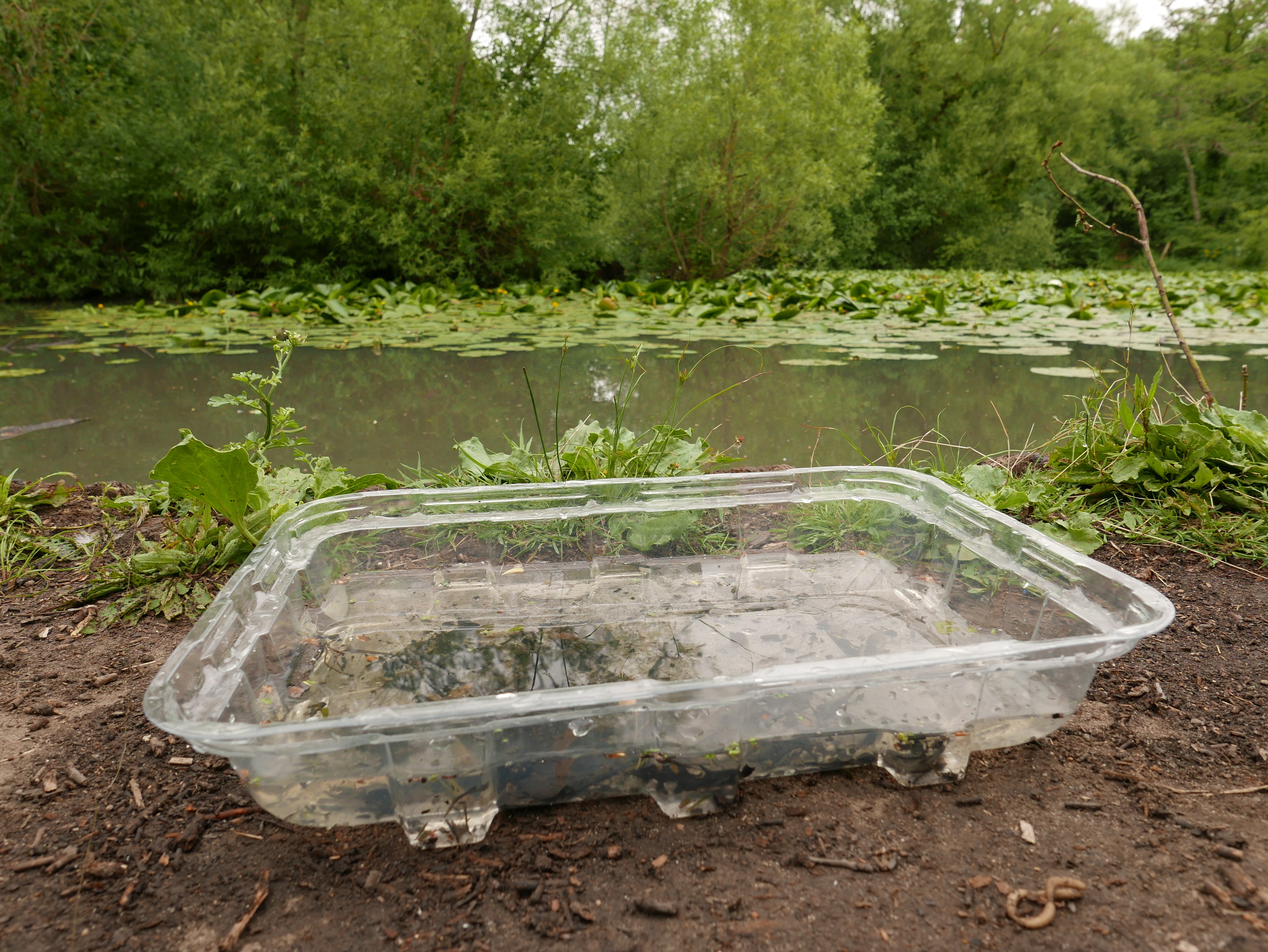
When you are pond dipping or looking for aquatic wildlife you can easily record your finding and submit the data to one of the following citizen science projects.
The Record Pool (Reptiles and amphibians in the UK)
Alien encounters (Non-native amphibians and reptiles in the UK)
Migratory Dragonfly Monitoring (USA, Mexico and Canada)
You can often easily find and observe many different types of birds in and around water. The RSPB have great picture guide to identifying birds here. There are many types of birds that feed on aquatic wildlife like Herons, King fishers and Egrets. There are also many types of waterfowl, which are birds that have waterproof feathers and webbed feet for swimming like geese, ducks, swans and coots. They often nest near water on banks or in reeds. If you are ever lucky enough to spot a wild bird nest or find an egg then the Woodland Trust have a guide to identifying eggs here. However please don’t disturb any wild birds nests you might find, please just quietly observe them it from a distance. Don’t touch or disturb either the eggs or the nesting site as that might then cause the parents to abandon the eggs.
Making your own birds nest is a simple, fun and educational activity for children of all ages, all you need is a few easy to find natural materials. February is often the beginning of nesting season for most birds but some nesting periods can last till August and a few birds (like wood pigeons) will actually nest all year round. Different types of bird will choose and use different materials and methods to build their nests. Many birds use twigs, grass and feathers to build them, some use mud, moss and fur and others like Chaffinches even use spider webs.
It is really simple to make your own basic birds nest using long grass gently twisted or woven into a circle. However if you don’t have any long grass you could use regular grass, leaves, sticks, mud or long stemmed plants to make your nest. Simply form a circular nest shape out of the materials.
You can then place ‘eggs’ in the centre of your nest. We used pebbles as pretend eggs but you could use anything you like from crumbled up paper balls to hard boiled eggs. You could even have a go at painting them to match the colour and patterns of wild birds eggs.
You can also make a more permanent nest to keep and use as a learning guide or for pretend play. They are surprisingly simple to make and required very few materials. You can find a full photo guide to making one here + additional bird nesting facts and resources.
A frog’s lifecycle starts with frogspawn. Frogspawn is made up of thousands of eggs laid in water. The reason frogs lay so many eggs is because most of them will not survive to adulthood. Many of them will be eaten by predators or dry up before they hatch. On average only 5 out of about 3 thousand eggs will eventually become adult frogs.
A frog egg consists of a tadpole embryo (which is the black spot) this is surrounded in jelly which the embryo will eat until its ready to hatch.
Tadpoles are the larval stage of frogs. Tadpoles are aquatic and live in water they have gills to breath and a tail to help them swim. They feed on plants, algae and the eggs, larva and bodies of other aquatic wildlife. Eventually the tadpoles will begin to grow arms and legs to become a froglet. Before finally losing the tail and emerging onto land as a frog.
Fake frogspawn is so simple to make and is great for sensory play and exploration. Simply make up a batch of plain jelly using agar or gelatine powder. When the jelly has set you can then gently stir it to break it up slightly, then gently mix in some black beans or seeds. (Please be aware of the choking hazard of any objects you use)
Potato printing is a simple activity for children of ages, all you need is a potato cut in half, a bit of inspiration and some paint to get started. How about making some potato print frogs. All you need is a half a potato dipped in green paint. You can then paint or draw on two little arms, legs and eggs. You could make potato print lilly pads for your frogs using a potato half with a triangle cut into the top.
Its also really simple to create frogspawn prints using a potato half dipped in white paint. The children can then add the black finger print dots of paint to the centre of the frogspawn.
Feed the frog is a cute little activity that’s perfect for developing fine motor skills and stimulating imaginative play. All you need is a cardboard box and paper or paint. First cut a mouth shaped hole into the side or top of a box. Then cut a simple frog shape out of paper (you could also use tissue paper or even old wrapping paper). Make sure to cut another mouth hole into the paper before you stick it onto the box as well as a hole in the back so the children can retrieve the food they post through.
Next cut out some little frog feet and two eyes out of paper. Stick all the pieces onto the box and your little frog is ready to feed. The children can have fun feeding the frog toy insects or pictures of insects printed onto paper or card.
Notes: * Please always be aware of the choking hazard of small objects and never leave young children unsupervised.
There are more than 5,000 known species of dragonfly worldwide, You may spot them flying about near water or find a dragonfly nymphs when pond dipping. There are about 30 species of dragonfly in the UK that you can find more out about on the British Dragonfly Society’s webpage here.
Did you know dragonflies spent the first few years of their life as underwater nymphs eating anything they can find. At the end of the larval stage they emerge out of the water and climb up vegetation where they take a few hours to moult, shedding the larval skin and hardening their legs, bodies and wings to become beautiful flying insects. We found the dragonfly nymph below last year whilst pond dipping.
Dragonflies are ferocious and very successful predators, they have a success rate of capturing over 90% of the prey they hunt which they devour quickly using serrated teeth. They are also amazing fliers, moving and rotating their four wings independently of each other so they can fly forwards, backwards, up, down, round and hover at high speeds. Most of dragonflies head is taken up by it’s eyes which gives them nearly 360 vision and amazing eyesight.
Nature art (also sometimes called land art) is a wonderful nature activity that encourages creativity and fine motor skills in children of all ages and abilities. All you need is some imagination and natural materials to make pictures, shapes and patterns or letters, numbers and words.
You could have a nature treasure hunt in the garden or go on on a nature walk to find natural materials to use like leaves, sticks, stones, shells, grass, plant stems, bark, fallen fruit, nuts, seeds and flowers*. *But pretty please don’t pick any wild flowers, only collect ones you have grown yourself or fallen ones you find on the floor.
You can make your dragonfly nature art as simple or as detailed as you like. The children can even paint and draw onto leaves to make colourful patterned wings. You could take photos of your finished artworks so you can then print them out and even turn them into cards to give to friends and family.
You could also make dragonflies using sycamore seeds for the wings and twigs for the body. How about painting the wings with bright colours to bring your dragonflies to life. Or attaching them to string so you can hang them up or fly them through the air.
Nature art frames are really simple to make, fun to play with and create some wonderful images. You just need an old piece of cardboard a pen and some scissors. We hate to waste anything and recycling and reusing materials is one of many small things we can all do to help the environment. So instead of chucking used cardboard boxes we like to find ways to use them in crafts and activities.
All you need to make a nature frame is to draw a simple shape or picture like a dragonfly or fish onto cardboard. Your shape or picture should have at least 1- 2 easy to cut out sections that you can then look through. When you have cut out the see through sections of your frames, you can take them outside to hold them up against any of the interesting natural objects, textures, patterns and shapes you can see, like the water, shore, sky, trees, flowers and grass for example.
Making leaf boats and rafts is such a simple and fun activity that encourages creativity in children of all ages and helps develop fine motor skills. All you need for this is some leaves and water to sail your boats on. You could use a puddle, pond, stream, river, lake or even just a bowl or bathtub at home.
Safety note: Children should be supervised at all times around open water. Please be aware of the health and safety risks, rules and restrictions of any area you visit.
To make a leaf boat you simply need to push the stem of one leaf through the middle of another leaf, then carefully pull a tiny bit of leaf end through so it stands up like a sail, with the leaf underneath serving as the base of the boat.
Now your boat is ready to set sail, just place it on some water and watch it float, it really is that simple! How about making multiple leaf boats and having a boat race. Or you could experiment with pushing the leaf boats across still water by blowing or fanning air onto the sails.
If you fancy more of a challenge you could try making a stick raft to float. All you need is some sticks and some natural materials to bind the sticks together like long grass or ferns. You can experiment with different materials and techniques to see which works the best.
You can often find animal prints in muddy areas right by water where animals go to drink and walk through soft mud. The Wildlife have a useful photo guide to identifying animal tracks here which you can use to help identify any prints you might find.
You can easily take a cast of any animal prints you find to enjoy and explore at home. All you need for this activity is some Plaster of Paris, water, a cup or mixing bowl and a spoon. Simply mix the plaster with water in the cup or bowl and then pour it onto the animal print. You could also make a simply cardboard collar or hoop to place over the print and contain the plaster but this isn’t essential. You then need to wait patiently for 30 minutes to an hour for the plaster to dry before carefully removing the cast of the print.
Ponds are important source of food, water and shelter for many animals and insects. From amphibians like frogs and newts, to aquatic mini beasts and insects like dragon flies (which begun their lives as underwater nymphs) and bats and birds that eat some of the insects. Making a small wildlife pond is very simple, all you need is a watertight container (or waterproof sheeting). Pond plants, rain water, soil, stones rubble and bricks.
Safety note: Open water of any kind can present a drowning risk for small children and pets. Please make sure your pond is secured in some way (with netting or barriers) so children and pets are prevented from accessing the water.
The first thing you need to do is dig a hole big enough to fit your container in. You then need to put a base of soil into the container to provide nutrients for the pond plants to grow in, and somewhere for water insects to burrow.
Next you need to make sure there is a basic staircase at one end to create an easy escape route for any wildlife that may fall in the pond. (To prevent accidental drowning). You could also add in some rubble and stones to provide hiding places for aquatic minibeasts.
Now you can fill the pond with rain water or water from a natural local source (you can collect it in buckets ) It’s best use natural water as it won’t contain any of the fluoride or other chemicals may be present in tap water.
The final and most important thing to put in your pond are aquatic plants that will create oxygen in the water and provide a source of food and shelter for pond creatures and insects. We used duck weed as our tadpoles love it and it creates a nice cover over the pond to give them lots of shelter.
Layering piles of rocks, stones, pebbles, bricks, paving slabs and plant pots close to the ground all help create cool shady nooks and hiding places for amphibians and reptiles like frogs, toads, slow worms, lizards, newts and snakes.
Old terracotta plant pots also make perfect amphibian and reptile shelters. You can either break them in half or half bury them in the ground to create a shady cool hideaway.
You can also create an underground den for amphibians to hibernate in during the winter. Amphibians like to hibernate in dark, damp safe spaces underground.
You can easily dig a hole in the ground that’s roughly 30-40cm deep. Line the hole carefully with logs, sticks and stones to create a series of mini spaces and holes for them to hide in. You want it to be stable so it doesn’t fall on any creatures but you also want to leave space for them to move about in.
Next partially cover over the top of the hole using half of an old flower pot or a plank of wood. You want to cover it enough to keep the worst of the weather and predators out whilst also leaving room for smaller animals to enter. If you are using a flower pot you could loosely line it with long grass to provide extra shelter. Finally cover over the top (leaving the entrance hole) with soil and sprinkle on some grass or wild flower seeds.
*For day 24 of 30 Days Wild 2021 we went pond dipping, took part in citizen science and learnt about the dragonfly lifecycle.
If you like this you might like to try:
Make a home for wildlife in your garden
Exploring the shore – 15 activity ideas
Exploring trees and woods – Activity ideas
June 18, 2019
June 6, 2020
12 ideas for finding insects and minibeasts
June 30, 2021
This post may contain affiliate links, meaning if you book or buy something through one of these links, we may earn an affiliate commission at no additional cost to you. Learn more
Plenty of us have bucket lists for things to do or places to see; that’s a given. But how many of us have a bucket list for water sports?
Water sports come in all shapes and sizes. They are fun, thrilling, and unique experiences. Because they are technical and require equipment, you can book to do all of them with a company, or professional.
Feeling like you need a challenge? Why not push the boat out (excuse the pun!) and experience something new? Here are 37 water sports to try at least once.
Table of Contents
These water sports are all done on the surface of the water. They are fun, exciting, and full of thrills. All are worth trying at least once in your life.
Canyoning is a breathtaking water sport to try at least once. Canyoning lets you explore Mother Nature in all her awe.
Swim, climb, jump, and walk through rivers, waterfalls, and canyons. The stream splashing against your skin. The mist of the waterfall. It’s a great outdoor activity.
Ride atop gushing whitewater in an inflatable raft with your friends or family. Whitewater rafting is rapid, pulsating, and definitely worth trying at least once.
There are even artificial whitewater pools you can ride if there aren’t whitewater rivers near you.
Subscribe to Nomad Paradise!Get updates on the latest posts and more from Nomad Paradise straight to your inbox.SUBSCRIBEI consent to receiving emails and personalized ads.
How fun does the flyboard flying look? Flyboards look like something out of Back To The Future. It’s a water activity you simply have to try.
Your first few goes will probably result in some hilarious video footage. But that’s all part of the fun. There are plenty of thrills and joy to be had flyboard flying.
Spinnaker flying is a fun water sport. Spinnakers are special sails attached to sailing boats, that catch the wind and elevate.
Attached to the sail, you can gracefully fly up into the sky. It’s a whole heap of fun and a delightful water activity.
You can kayak through many bodies of water. The little brother of canoeing, kayaking is a great way to enjoy the outdoors.
With your paddle, you can kayak through calm waters and enjoy the view. Or, you can take it up a notch, and try some rapid waters. Plenty of fun.
Canoeing uses a single-bladed paddle, and it is often done with one, two, or more people.
From shimmering lakes to wild rivers, there’s so much to explore in a canoe. Its a brilliant water activity try try at least once in your lifetime.
Difficult to master but so much fun to try, wakeboarding sees you towed by a boat as you stand on a wakeboard. It’s like surfing, with a little help!
We’ve all seen hilarious videos of people falling off wakeboards. As water activities go, this is an adrenaline rush, for sure.
Wakeboarding too difficult? You should definitely give kneeboarding a try.
Kneeboarding uses a board you kneel on, and you can strap yourself with velcro too. This means it’s easier to stay on the board and have lots of fun.
Want to drop the pace a little? Paddleboarding is a wonderful water activity to enjoy the great outdoors.
You can either stand or knee on a paddleboard. Gracefully, use your paddle to sail through calm waters and beautiful scenery.
Skimboarding is too much fun. It allows you to surf through very shallow water, and it is less technical than surfing.
Simply slide your skimboard through shallow waves and jump on. It’s a fun water sport for plenty of ages and abilities.
Want to experience the rush of riding a wave without having to stand up on a surfboard? Try bodyboarding.
Once you catch that perfect wave, hold on as you propel through the water toward the beach. It’s such a rush and so much fun.
Let’s take it up a few notches once more! Towed from the back of a boat, water skiing is an exhilarating experience.
It will take a few goes to get the hang of it. But once you start staying on your feet, the thrill is so powerful. A must-try water activity, that’s for sure.
Yes, you read that correctly! If your boat travels fast enough, at least 50km/h, you can ski off the back without needing skis!
At such speeds, the adrenaline truly takes over. It’s a water sport that’s fast, furious, and gets the pulse racing.
A water sport with such a devoted following and epic history, surfing is a water sport rush like no other.
When you stand up, and you’re riding that wave for the first time, the feeling is euphoric. It’s a water sport you simply have to try.
There’s something awe-inspiring about conquering one of Mother Nature’s massive creations.
Cliff diving is a rush like no other. For a brief moment, you feel like you’re flying. It’s daring, thrilling, and an experience you’ll never forget.
Jet skis are stylish watercrafts, and they are so much fun to ride. On your own, or with someone else, twist the throttle and hit the waves.
You can travel at some breathtaking speeds. The feeling of roaring through the waves makes this a must-try water sport.
Kite surfing takes surfing to a whole new level. Once your kite catches the wind, you’ll be propelled across the top of the water.
It’ll take a few attempts to get used to it, but once you catch your first gust, the feeling is incredible. It’s a breathtaking water sport and has a large community all over the world.
As you can imagine, a sail attached to your surfboard takes things up a few notches. Windsurfing is a beloved water sport and one you should definitely try.
Combing the thrill of riding waves, while getting air time from the sail, is an adrenaline-fueled adventure. Even to watch, windsurfing is majestic.
Who doesn’t love a great rom-com with a rowing boat scene? There’s something magical about taking a rowing boat out onto a lake.
Rowing allows you to calmly glide through the beauty and rush of nature. It’s relaxing, a good workout, and a great way to spend an afternoon.
Parasailing is a fun, thrilling water activity that most people can do. Towed by a boat, once you pick up speed you’ll sail high into the sky.
Looking out over the land from above is breathtaking. Parasailing is definitely one of those water sports to add to your bucket list.
If you’re looking for water activities to do with other people, you’ve come to the right place. Team water sports are competitive and mostly done in swimming pools.
Here, you’ll get the chance to try some unique experiences. All the while, you’ll challenge yourself, keep fit, and meet new people.
These are all great reasons to try these water sports at least once.
Ready for a little rough and tumble? Underwater rugby takes the famous oval-ball game and plays it in a pool, beneath the surface.
Purely just to say you’ve done it, it’s worth trying at least once. It’s tough, frantic, and plenty of fun.
Underwater hockey has a global community of players. It’s limited contact and requires plenty of skill to move the puck along the bottom of the pool.
If you like your underwater sports with less contact and more technique, underwater hockey is worth trying. It’s challenging, unique, and lots of fun.
Picture a cross between underwater rugby and hockey, and you have underwater football.
Requiring plenty of skill and effort, underwater football is a game for great competitors and thrill-seekers. It’s a memorable experience and worth trying once.
Water polo is one of the most popular team water sports. You’ve probably watched it during the Olympics. It’s played in countries across the world.
Water polo is frantic, skillful, and a really good workout. Plus, it’s a great way to bond with others and be part of a community.
Water volleyball is so much fun to play. On holidays, it’s commonly the game everyone loves to play in the swimming pool.
It’s a great way to make friends, and get in a good workout. From hotel pools to Olympic pools, there are so many places to try water volleyball.
Love tearing up the dancefloor and busting out a move or two? If so, synchronized swimming is definitely the water sport for you!
You may have seen synchronized swimming on television. It’s technical and challenging, but so much fun to try. Plus, you’ll get to dance to some groovy music.
Sailing is one of the most well-loved water sports in the world. It’s a wonderful way to spend time out on the water.
Sailing is very technical, so you’ll need to try it with a professional. But once you get the hang of it, it’s so rewarding.
Sailing through blue waters, watching the sun on the horizon, is a sight you’ll never forget. Sailing is definitely worth trying at least once in your life.
Water aerobics is a true community water sport. Classes are done in swimming pools across the globe.
Water aerobics is great for people of all skills. Whether you’re an accomplished swimmer or new to the water, it’s challenging and lots of fun.
Water aerobics classes are usually done to lively, fast-paced music. It’s a great way to meet new people and stay fit. A water sport to try at least once, for sure.
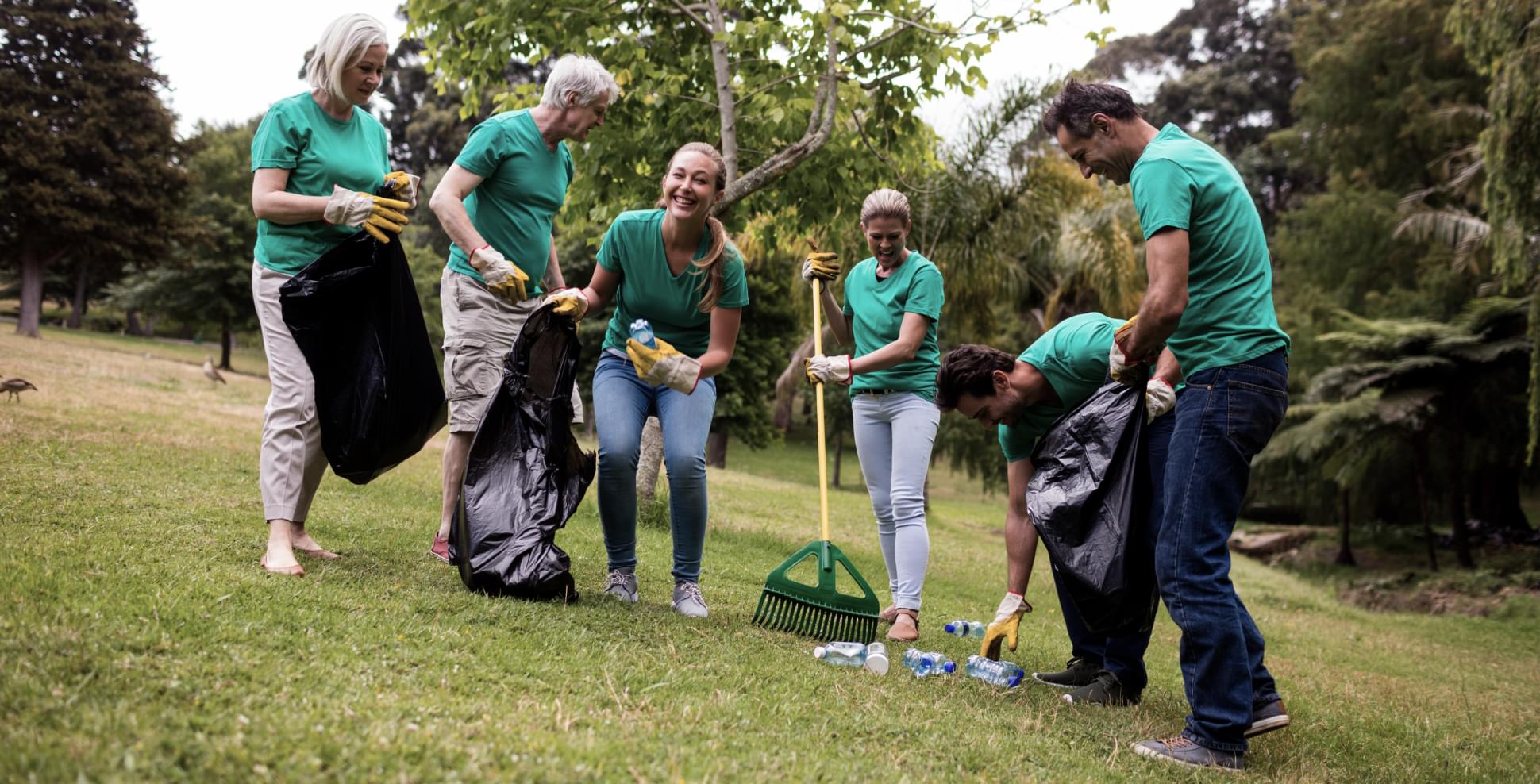
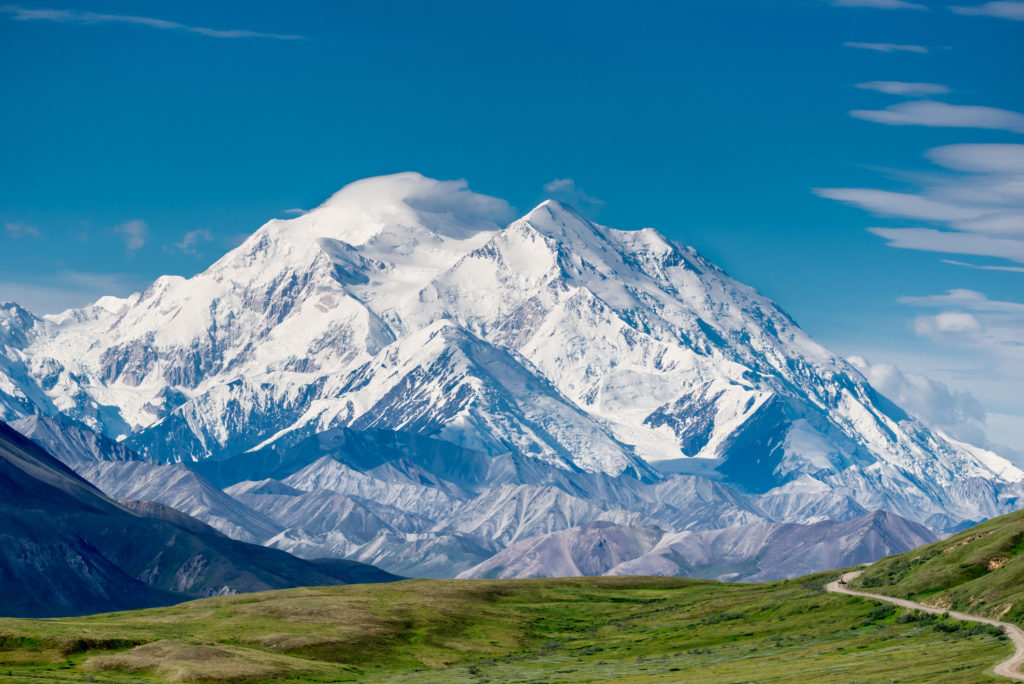
Written by Adventure Together
Categorised Destinations, North America, United States
Famous writer and historian, Wallace Stegner once called our national parks, “America’s best idea”. We would agree wholeheartedly! Some of the U.S.’s most amazing landscapes are found in our beloved national parks. Our national parks practically cover every kind of landscape you can imagine–from sandy beaches to active volcanoes, to glaciers and mountain peaks, to rain forests and everglade forests, to desert sand dunes…Our national parks are a treasure and the reason why millions of people from all over the globe want to visit them each year.
Looking for a new national park to explore as a family or want to plan an epic road trip to cover a bunch of national parks? We’ve compiled a list of the top 25 national parks to visit with kids, contributed by top outdoor and family travel bloggers! (*Note: This list is in no particular order.)
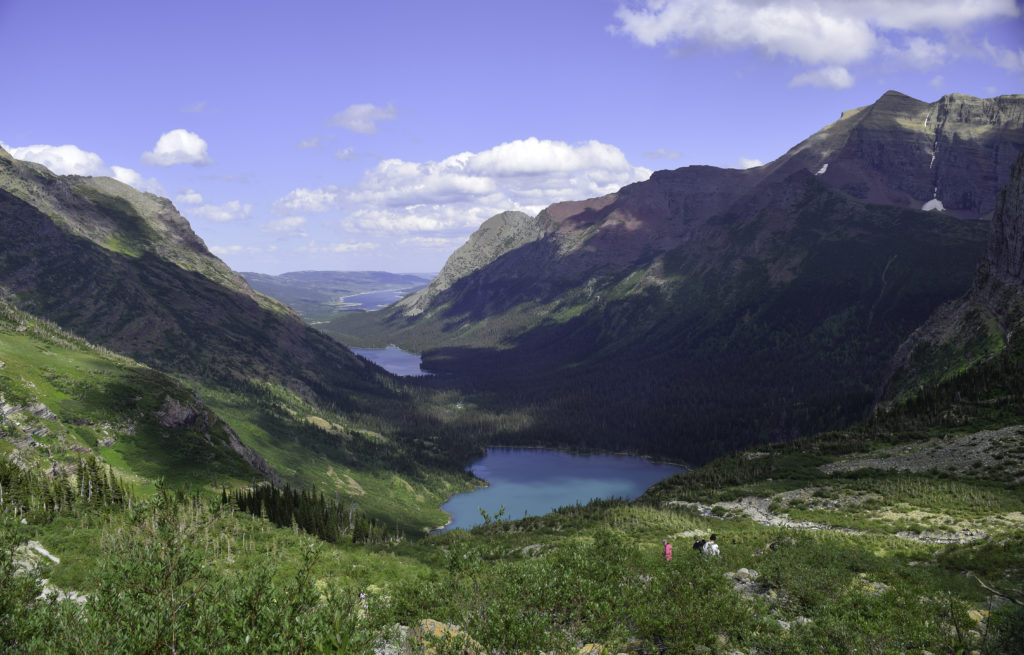
Glacier National Park in Montana is considered the crown jewel of North America.
Located five hours north of Anchorage and just two hours south of Fairbanks, Denali National Park is one of the most popular, and most accessible Alaskan national parks. Made famous for North America’s highest peak, Denali (otherwise known as Mt. McKinley, or the High One), the park is six million acres of mostly road-less terrain, save for a 92-mile dirt road reserved for shuttle buses and permitted private vehicles on their way to a few primitive campgrounds within the park boundaries.
The “real” Alaska is seen everywhere in Denali, from grizzly bears digging for meals within the tundra to herds of caribou wandering near the Park Road, Denali’s magic lies within its remoteness. The entrance area is special, too; families will especially enjoy the easy-to-navigate trail systems any time of year, and a hands-on visitor center provides ample information for curious young visitors with Junior Ranger programs, guided hikes, and backpacks full of interesting tools for exploration available for check out.
Don’t forget to stop by the kennels of the National Park Service’s only canine ranger force, too. The Denali National Park sled dog team is a vital part of winter trail patrols, but in the summertime they are busy snuggling up to visitors during the thrice-daily presentations.
Erin Kirkland is Alaska’s only family travel expert. She is author of the Alaska On the Go guidebook series, and is publisher of AKontheGO.com, a website dedicated to family travel and outdoor recreation.
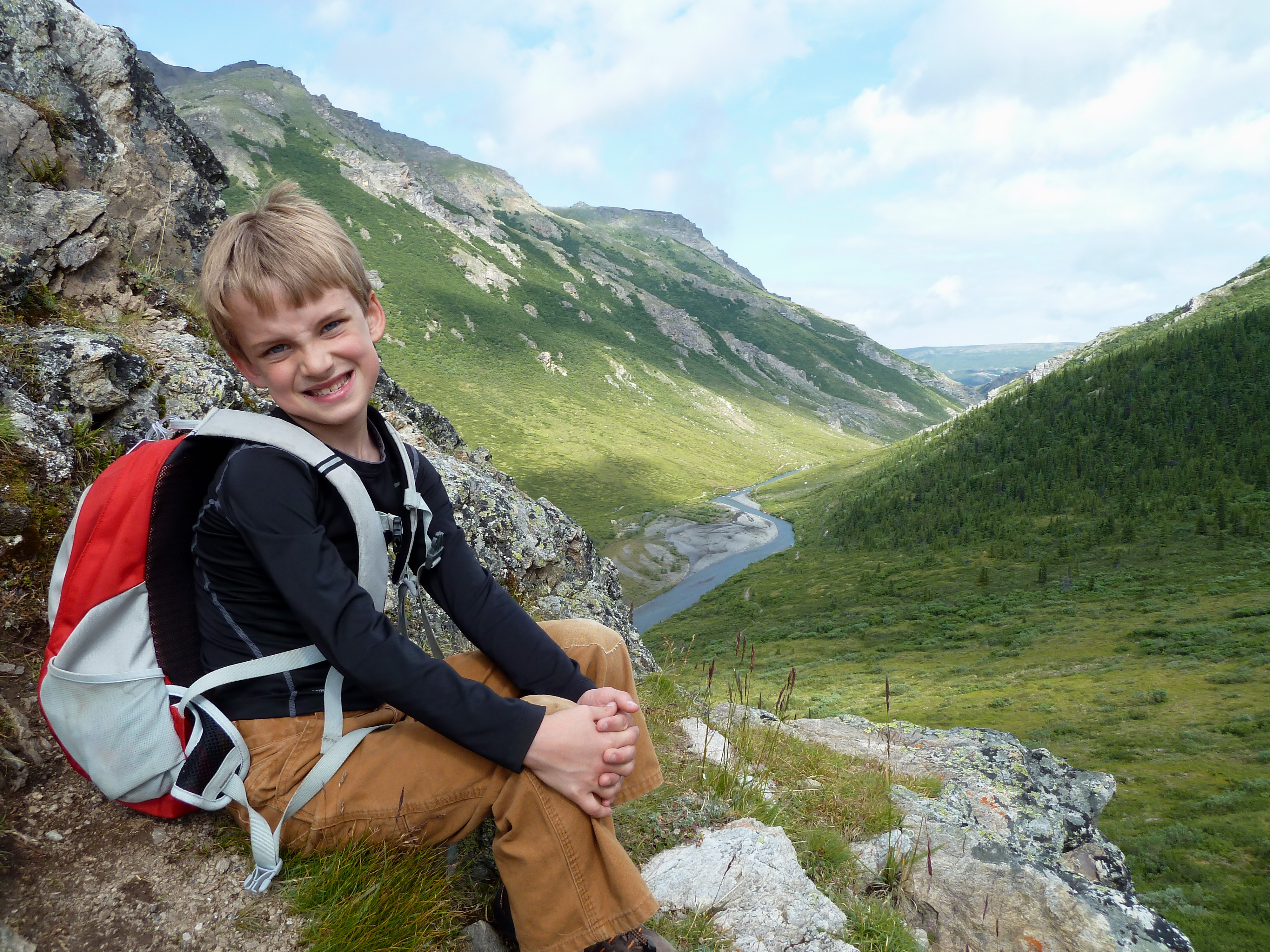
Enjoying the view on a hike in Denali National Park, Alaska. Photo cred: Erin Kirkland of AKontheGO.com
As America’s first national park, Yellowstone National Park is unique for historical reasons along with the diverse natural features that gave this park its nickname in the nineteenth century, “Wonderland.” While parental caution is a must – because of boiling thermal features, steep drop-offs, and a menagerie of wildlife – there is nothing quite like witnessing your child experience their first geyser eruption, watch the Yellowstone River fall hundreds of feet into a canyon, or appear wide-eyed as a heard of bison lazily meander across the road in front of your car.
Highlights in Yellowstone include Old Faithful, Grand Prismatic Spring, Mammoth Springs, and the Grand Canyon. Yellowstone National Park should be on every outdoor family’s list of places to visit. And Yellowstone is a hiker’s paradise with hiking trails accessible to the roads, as well in the backcountry. Make sure to check out Old Tom’s trail, Fairy Falls trail (for the best views of Grand Prismatic Spring), and Mount Washburn trail.
Michael Barton is the author of The Nature Book Nook and runs the Facebook page Children at Nature Play.
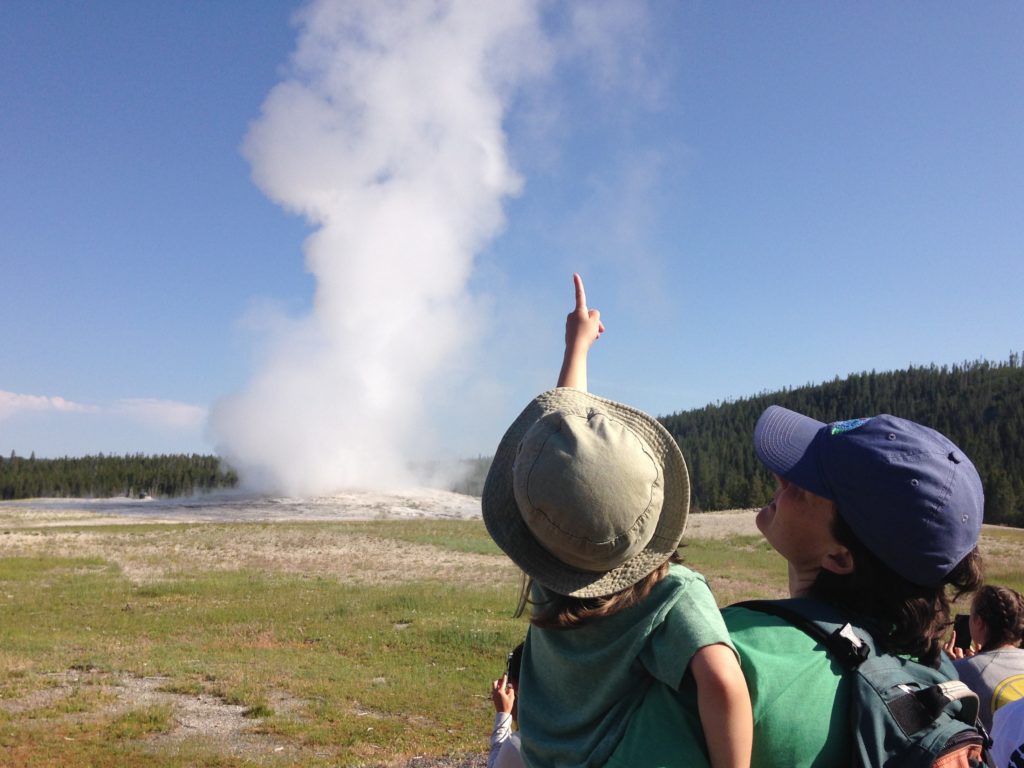
Mom and daughter watch an eruption of the Old Faithful in Yellowstone National Park. Photo cred: Michael Barton
The shades of red, yellow, and orange on the steep rock faces towering over the sparkling blues of the Virgin River that winds its way through the green valley of Zion National Park make this park one of our family’s favorite national parks. Zion offers a wide range of hikes in a small area and almost all the trailheads are accessed only a few steps from the free shuttle bus that takes you into the park’s canyon.
While Angel’s Landing is a must do for those who aren’t scared of heights, I recommend getting an early start because the hike can get really crowded and slow on the section of trail that involves climbing up the chains.
Two of our favorite hikes in Zion are Observation Point and Hidden Canyon (both start at the Weeping Rock Trailhead). The views at Observation Point are epic, however it may be hard to get your kids to hike the 8 strenuous miles. Luckily, there’s another fantastic 3 mile hike where the trail splits right after some switchbacks: Hidden Canyon is perfect for kids and anyone who enjoys scrambling through a tall, slot canyon.
*Extra Bonus: Get a permit and hike The Subway (one of our all-time favorite hikes and pictured below) or The Narrows. After a hard day hiking, rent some inner tubes and float down the river or head into town for pizza and beers at Zion Pizza and Noodle Co. Camping at Watchman or South Campground makes it very easy to access the trails, river, and restaurants in Springdale, as well as quick access to the shuttle bus.
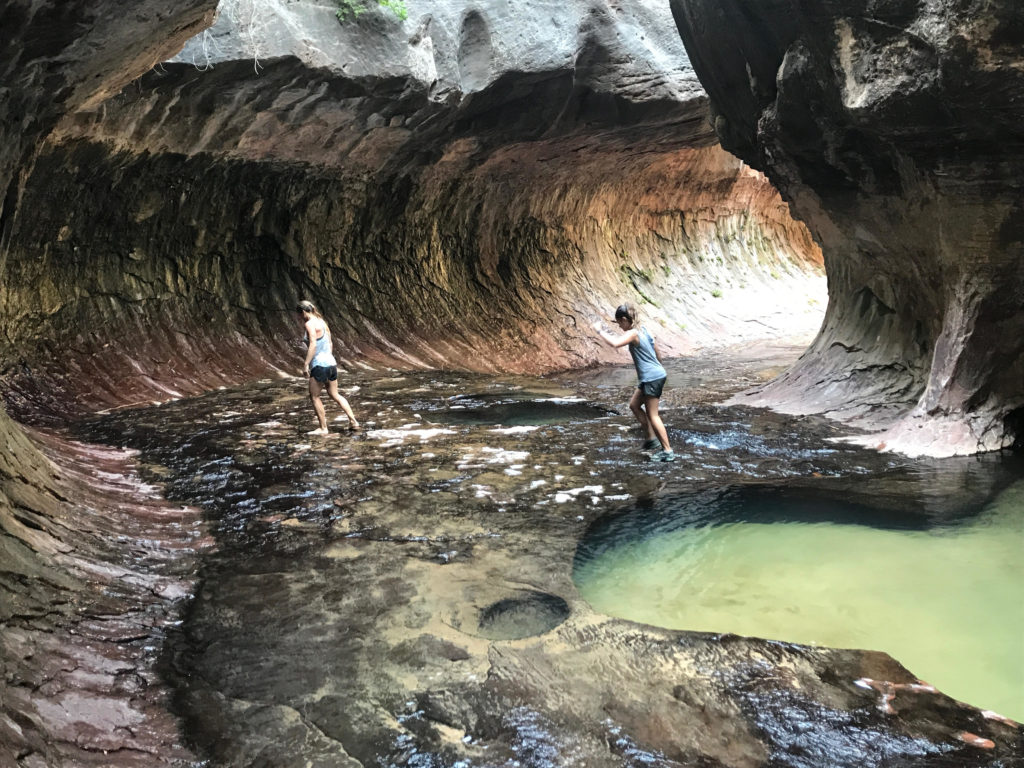
Hiking in The Subway at Zion National Park. Photo cred: Robyn Robledo
Robyn Robledo and her nomadic, outdoorsy family of seven travel full-time and blog at Nomads With A Purpose where they also guide trips for families searching for out-of-the-box adventures! You can also find them on Instagram.
Arriving in Death Valley National Park is an experience like no other. The landscape is harsh, intriguing and a little bit surreal. From sand dunes to salt flats, and mountains of every conceivable color, Death Valley constantly changes as you explore further into the park. If you’re there in summer, you’ll soon learn why it’s earned its reputation as the hottest place on earth and you’ll largely stick to a driving tour. However during the cooler months, there are some great walking tracks spread throughout the national park to explore.
Sights worth exploring in Death Valley (and amazing photo opps) include Zabriskie Point, Aguereberry Point, Dante’s View, and Artist’s Palette (also known as Artist’s Drive). Also, don’t miss hiking the Mesquite Flat sand dunes, Badwater Salt Flats (both easy hikes), and Mosaic Canyon.
Nicci O’Mara is the founder and editor at Trip Chiefs, where she writes about great destinations and adventures to take boys.
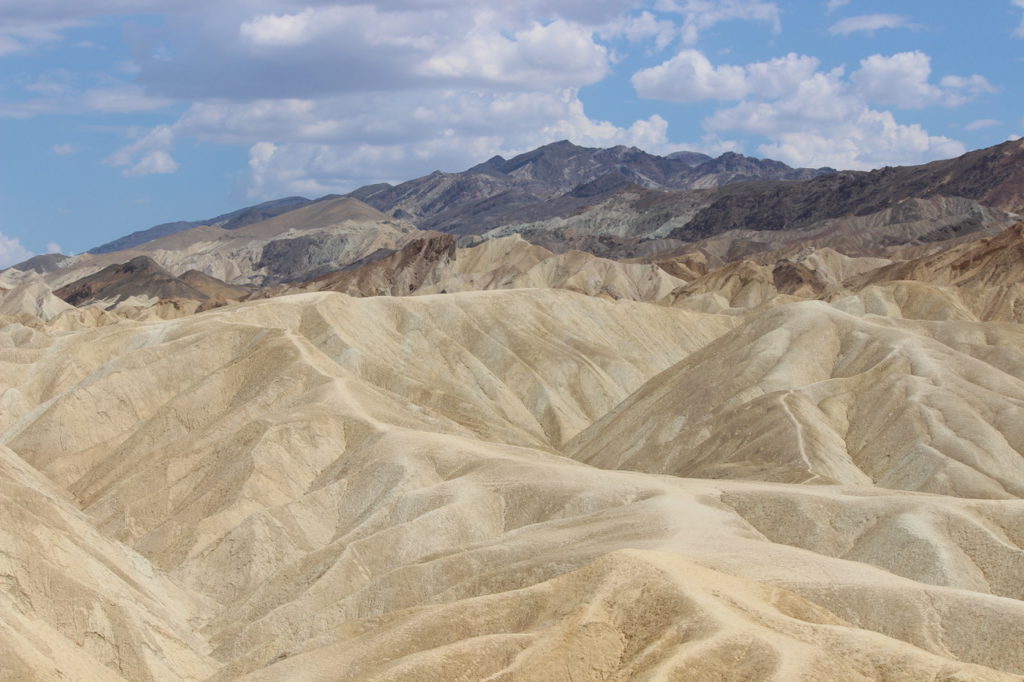
Death Valley National Park captured from Zabriske Point. Photo cred: Nicci O’Mara
If you ask the kids what they love most about Rocky Mountain National Park, they’ll each have a different answer. One will tell you it’s the wildlife: the elk, deer, and magpies that can be spotted all over the park. Another can’t pass up the exciting drive along Trail Ridge Road, the highest continuous paved road in the US. Our oldest will tell you the hiking is the best. Bear Lake trail is a favorite kid-friendly hike.
Although it’s a heavily trafficked trail, in the winter months the lake freezes over and you can walk on the lake! And while you’re there in those colder months, bring your sleds and stop by the Hidden Valley area for a few runs down the tubing hill. Year round, be sure to check out the Youth & Family programs offered by the Rocky Mountain Conservancy.
Many of these expert-led programs are free for kids, and is an amazing opportunity to learn about the park environment and activities to do within the park. If you’re not staying the night at one of the park campgrounds, then end your RMNP visit in nearby Estes Park. Restaurants, shopping, or a visit to the historic Stanley Hotel is a perfect end to a day in the Rockies.
Kiersten Einsweiler is a blogger and founder of Hiking In My Flip Flops and can also be found on Instagram.
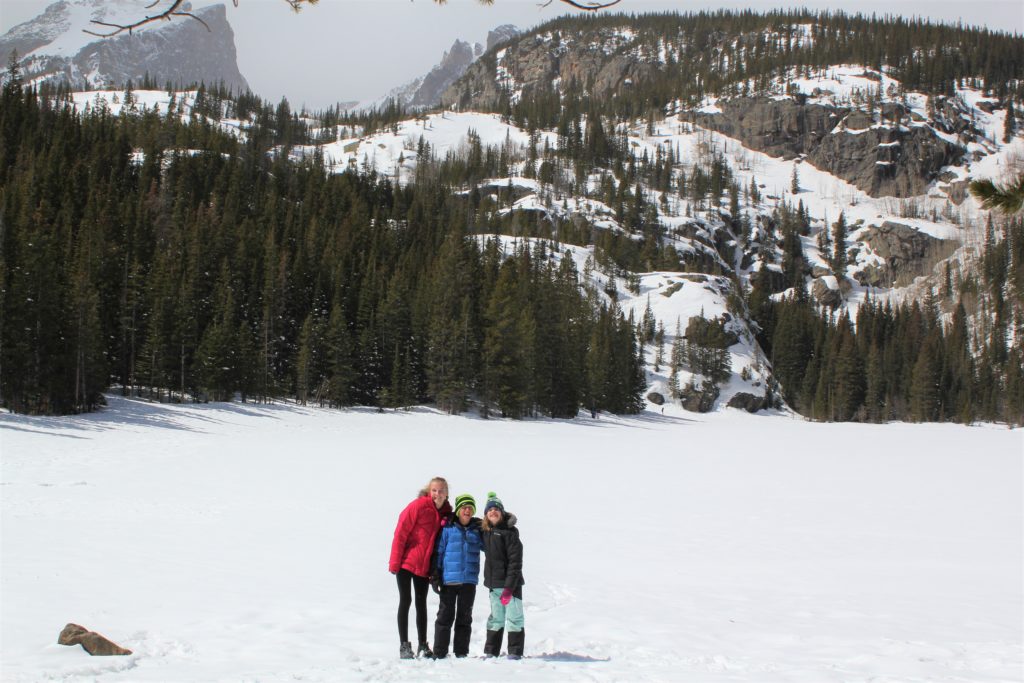
Enjoying the winter wonderland at Rocky Mountain National Park, CO. Photo cred: Kiersten Einsweiler
Visiting Hawaii Volcanoes National Park was at the top of our “must-do” list while vacationing on the Big Island. One of our favorite activities was hiking across a crater along the Kilauea Iki Trail. We started at the trailhead along the Chain of Craters road in a lush jungle. Once we started the descent into the crater, the landscape quickly changed from tropical rain forest, to barren rock garden.
The trail across the crater felt like we could have been on the moon! We also visited the Kilauea Caldera Overlook at night, drove the Chain of Craters road, explored the Thurston lava tube, and witnessed the flowing lava. Finding the surface lava included a 4 mile bike ride and a 1.5 mile hike (no small feat for kids!), but it was so incredible to be near such a powerful force of nature!
Jess Curren and her airstream-living, outdoor-loving family, blog about their adventures and travels at Currently Wandering and can also be found on Instagram. Read more details on their trip to the Hawaiian Volcanoes National Park.
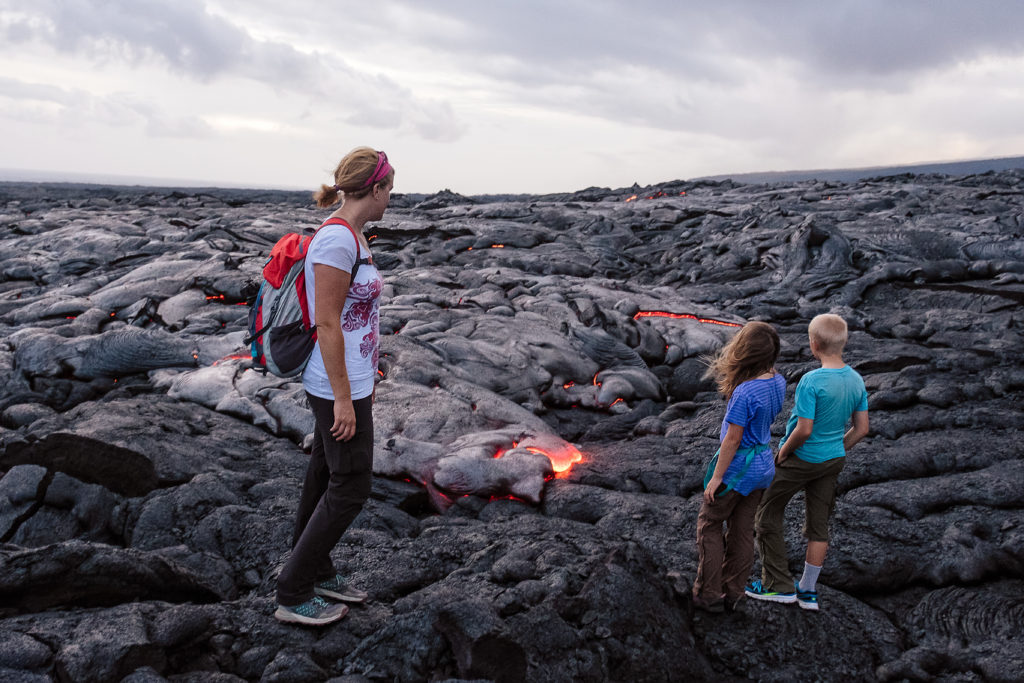
There’s nothing like seeing hot lava up close and personal at Hawaii Volcanoes National Park. Photo cred: Jess Curren
There’s no place quite like Northern California, specifically the Redwood Forest National Park. It’s a great place for kids to experience a unique side of nature, hiking and climbing around the 2,000 year old trees. As you hike among the massive trees you feel as if your exploring another planet. Standing next to these towering trees will make you feel small, but at the same time leave you feeling at peace.
You may feel like an Ewok or think a T-Rex may jump out at any moment because Star Wars “Return of the Jedi” and Jurassic Park “Lost World” had scenes filmed in this magical national park. That’s why it’s our favorite national park! There are so many great hikes and trails in the Redwoods, but a few noteworthy ones are Fern Canyon (otherwise known as James Irvine-Miner’s Ridge Loop), Redwood Creek trail, Lady Bird Johnson Grove, and Boy Scout Tree trail.
Dylan Myers is a family travel blogger at Family Travel Go where you can find more information on their trip to the Redwood National Park. You can also follow their family travels and adventures on You Tube.
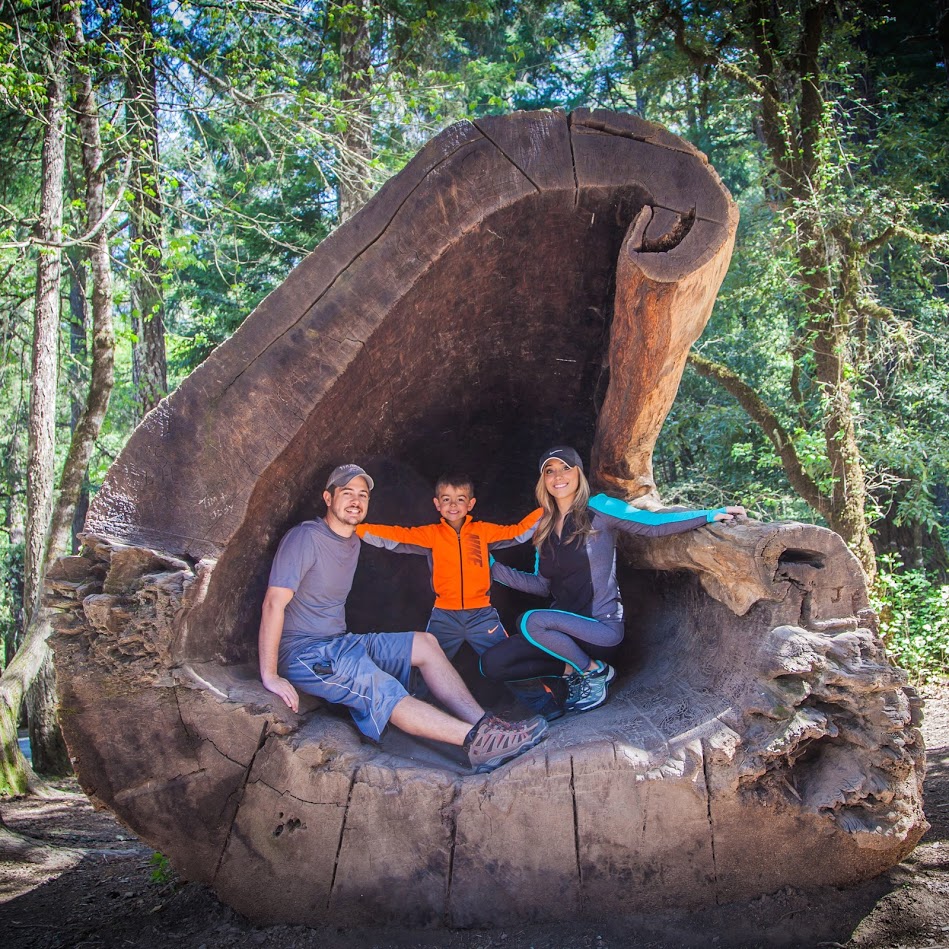
Climbing inside a giant, ancient Redwood tree is a pretty surreal experience. Photo cred: Dylan Myers
The first national park formed east of the Mississippi River, Acadia National Park, boasts 125 miles of hilly or mountainous hiking routes ranging from easy to strenuous, and the views from the seaside trails, in particular, are truly magnificent. Gorham Mountain trail, our family’s favorite, begins just past Thunder Hole on the right. Follow this moderately difficult path up the south side of the mountain, ascending through Cadillac Cliffs, scrambling through the caves, and arriving at the magnificent views of the 525-foot Gorham Peak.
Once at the top, you can turn around and complete the 1.8 mile loop or continue down the north side of the mountain to cool down at the Bowl, a fun swimming lake. If you want to eat your weight in fresh Maine lobster, Thurston’s Lobster Pound is a must-stop while in the park, or stop in at Jordan Pond House for yummy popovers and take any easy stroll around Jordan Pond nature trail where you’ll find crystal clear waters perfect for exploring a skipping rocks.
Jennifer Fontaine is a health, wellness, and family travel expert and founder and managing editor of Outdoor Families Magazine.
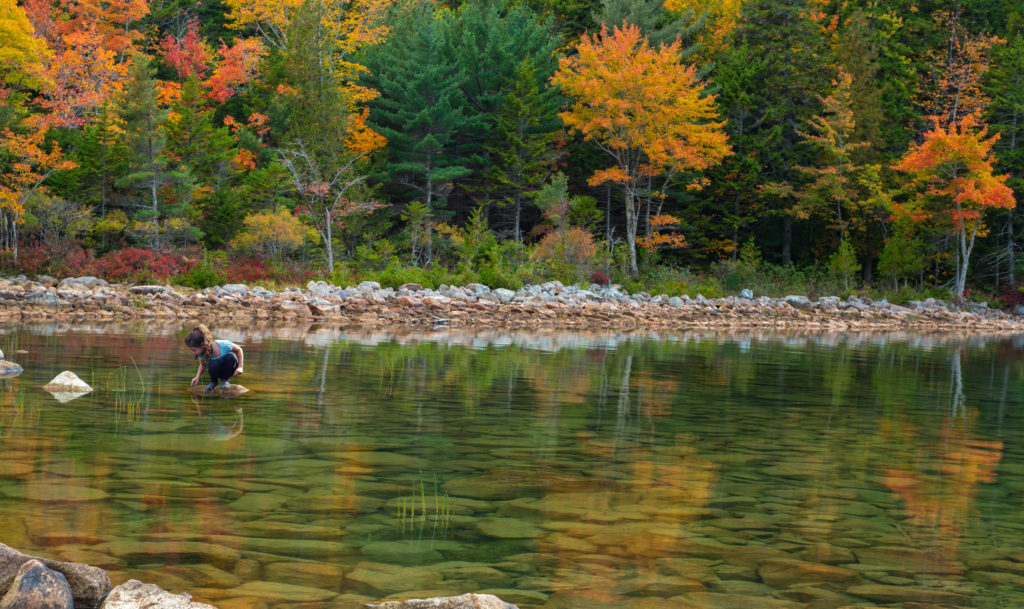
Fall is arguably the most beautiful time of year to visit Acadia National Park in Maine. Photo cred: Kerem Hanci
The National Park of American Samoa is the only national park south of the equator. The park is spread across three islands in the South Pacific, with 9,000 acres of land and 4,500 acres of coral reef and ocean. Two of our favorite hikes are the trail to Mt. Alava, which runs along the top of the ridge of Tutuila Island, with sloping views down to the ocean on both sides; and the World War II Heritage Trail, which takes you past old World War II gun emplacements.
Both trails have different length options, making them great for any age. The beaches are mostly untouched and usually empty, so you have room to explore or relax. From lush tropical rain-forests, to an underwater wonderland, the National Park of American Samoa is a family adventure just waiting to happen. If you ever make it to the South Pacific, be sure to check out this jewel!
Melinda Clayville is a family travel blogger at Traveling Outside the Box, where they write and share about their often unconventional travels while living in American Samoa. You can also read more about their lives residing in American Samoa.
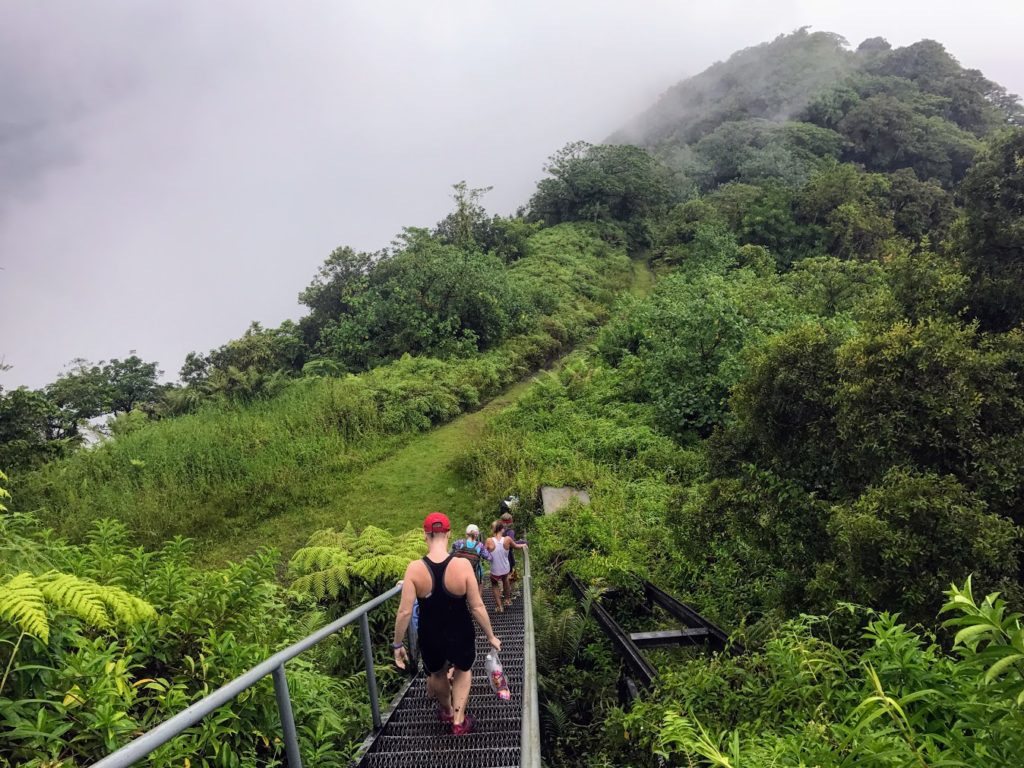
Exploring one of the many hiking trails along the American Samoa National Park. Photo cred: Melinda Clayville
South Dakota’s Badlands National Park is part scenic wonder and part world’s best playground. You won’t find any signs warning to you to keep out of certain areas; you and your kids are free to explore off trail and climb buttes to your heart’s content. The Door Trail starts out with a short boardwalk and some great views, and then you can keep on exploring after the maintained trail ends, following yellow paint marks deeper into the Badlands.
The Notch Trail requires a climb up a log ladder on the side of a cliff; I don’t normally get along so well with heights, but I made myself do it and was rewarded with more great views and a sense of accomplishment (tempered a bit by the fact that my four year old made the climb, too). Aside from hiking and climbing, there’s a great visitor center, a full schedule of ranger programs, and a scenic drive through the park with lots of great wildlife spotting (some of the highlights for us were spotting Bighorn sheep and prairie dogs).
Gretchen Holcombe writes about their family RV travels at Boxy Colonial On the Road, and you can read more about their visit to Badlands National Park on their blog.
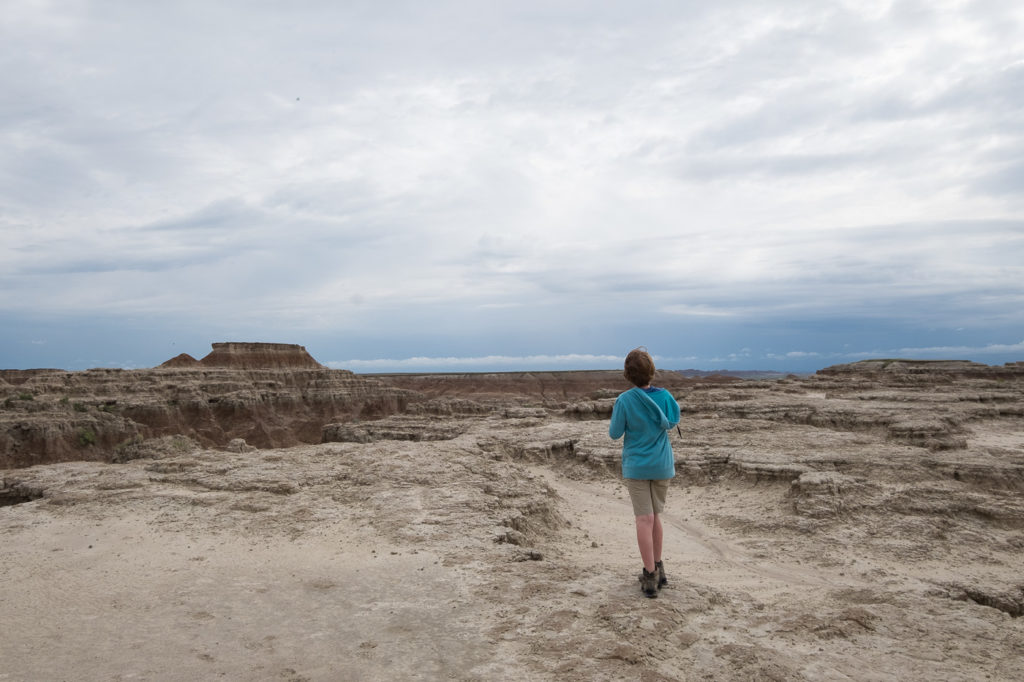
Wandering through Badlands National Park is a unique experience. Photo cred: Gretchen Holcombe
Arches National Park is home to the iconic Delicate Arch, but what people don’t often know is that the entire park is a nature-made playground for kids. Most of the hikes to the natural rock formations are between .25 and 5 miles round trip, making them very accessible for families with young kids. And while the awesomeness of these unique rock formations is often lost on kids, scrambling over sandstone, playing in fine orange sands, and spotting tiny lizards make this one amazing place to visit for families! Our favorite hikes in Arches include Delicate Arch, Double O Arch, and Black Angel Arch.
Alyssa Erickson is an outdoor enthusiast based in Utah and blogger for Kid Project, where she writes about the best outdoor adventures for kids in Utah and beyond, as well as gear reviews. You can read more about their favorite hikes in Southern Utah or follow their family adventures on Instagram.
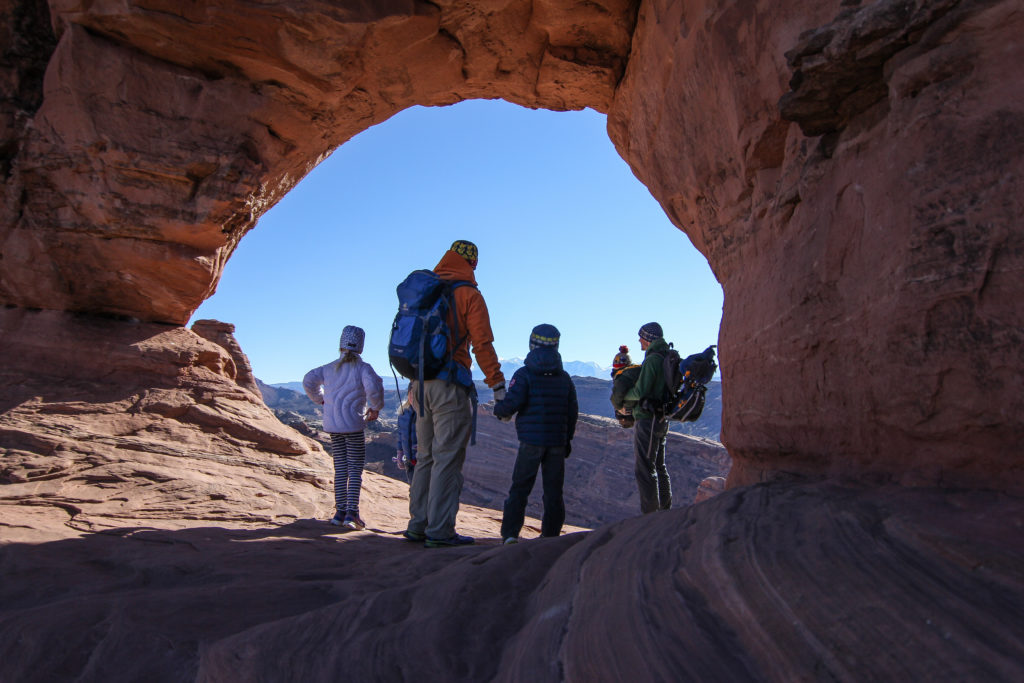
You can’t beat the views along the trail to Delicate Arch in Arches National Park, UT. Photo cred: Alyssa Erickson
Mount Rainier National Park includes over 12,000 feet of vertical relief from the dense rain forests to the barren, glaciated summit. In between are adventures suitable for everyone from kids in backpacks to teens that think they’re invincible. Each season provides unique opportunities whether snowshoeing in winter or strolling through brilliant fields of wildflowers in summer. The hike to Second Burroughs from the Sunrise Visitor Center is one of the best in the Park, but only available for a few short months during the summer. The summit puts you face to face with the upper Mountain, but even if you don’t go all 4.5 miles to the top the views will astound you, reminding you there’s a lifetime of adventures on Mount Rainier so neither you nor the kids will ever get bored.
John Soltys and his family reside in the Pacific Northwest, where he writes for Moose Fish and provides tips for outdoor adventures in beautiful Washington. Make sure to read his guide for adventures on the east side of Mt. Rainier for more ideas on what to do in Mount Rainier National Park.
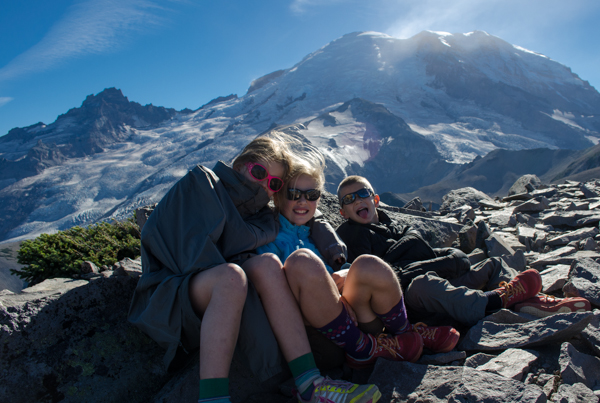
It’s hard to believe that Mt. Rainier is covered in glaciers! Photo cred: John Soltys
When we are looking for a family adventure, we tend to stay away from crowds and get off the beaten path, especially if we are visiting a national park. We love to dive into the history of the area and spend our time soaking up the natural beauty that surrounds us. Voyageurs National Park has more than 340 miles of navigable waters and 600 miles of rocky shoreline, making any water-based activity the highlight of your time in this National Park.
This is a park that I not only grew up going to every summer, but now have the opportunity to share it with my own children. Motorized boats are allowed in Voyageurs, unlike the neighboring and more rustic Boundary Waters Canoe Area Wilderness. Boating, canoeing, kayaking, swimming, fishing and hiking can fill your days while visiting this hidden gem. Swimming in these gorgeous lakes is by far our favorite daytime activity and marveling at the star filled sky from our campsite makes nights just as enjoyable.
If you’re lucky, you may even fall asleep to the sound of wolves. The lakes offer the chance to spot a variety of wildlife, including a few Minnesota mosquitoes! Many people rent houseboats to travel through the connected lakes, but there are also more than 200 campsites, only accessible by boat. Be sure to enroll your children in the Junior Rangers program, by picking up materials at one of the three visitors centers that are spread across the park.
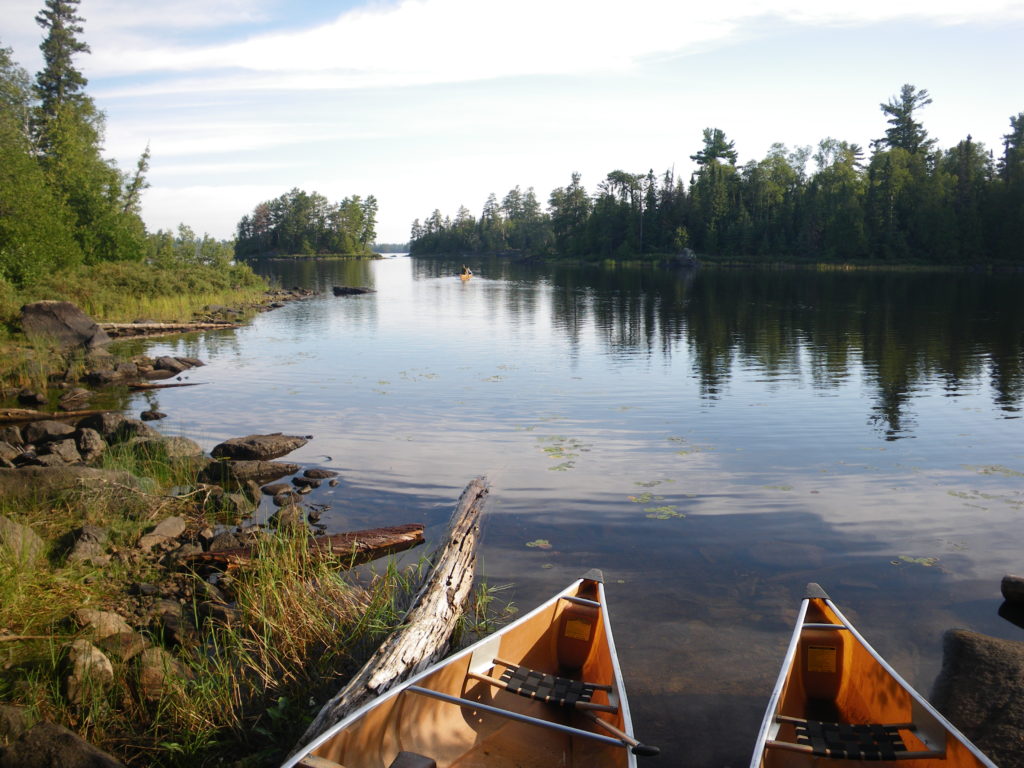
Canoeing along the shoreline of Voyageurs National Park in Minnesota and finding boat access-only campsites is a unique experience while visiting this national park. Photo cred: Kayla Keigley
Kayla Keigley is a family travel blogger at Wanderlocity residing in the Pacific Northwest, where she writes about all things adventure for little ones off-the-beaten-path. You can also follow their adventures on Instagram.
Joshua Tree National Park is a great park for all ages – and one of our favorites! For young kids, there are easy trails and endless open spaces to run around. Older kids can enjoy more strenuous hikes and there are plenty of giant boulders to climb and explore. For more adventurous families, give rock climbing a try on a number of the massive rock structures. Cholla Cactus Garden (go at sunrise!), Arch Rock, and Cottonwood Springs are a few of the best hikes Joshua Tree has to offer. Also, keep in mind that Joshua Tree is a desert, so you’ll find very hot summers and cold winters. Spring and fall are the best time to visit, but it’s worth the trip any time of year. Make this one a camping trip too for some of the most incredible stargazing.
Laura Gibbons is a travel blogger with Let’s Go Little One, where she writes about their family travels with a focus on culture, courage and education to encourage families with young kids to explore the world around them. You can also follow Laura on Instagram where she documents their beautiful adventures.
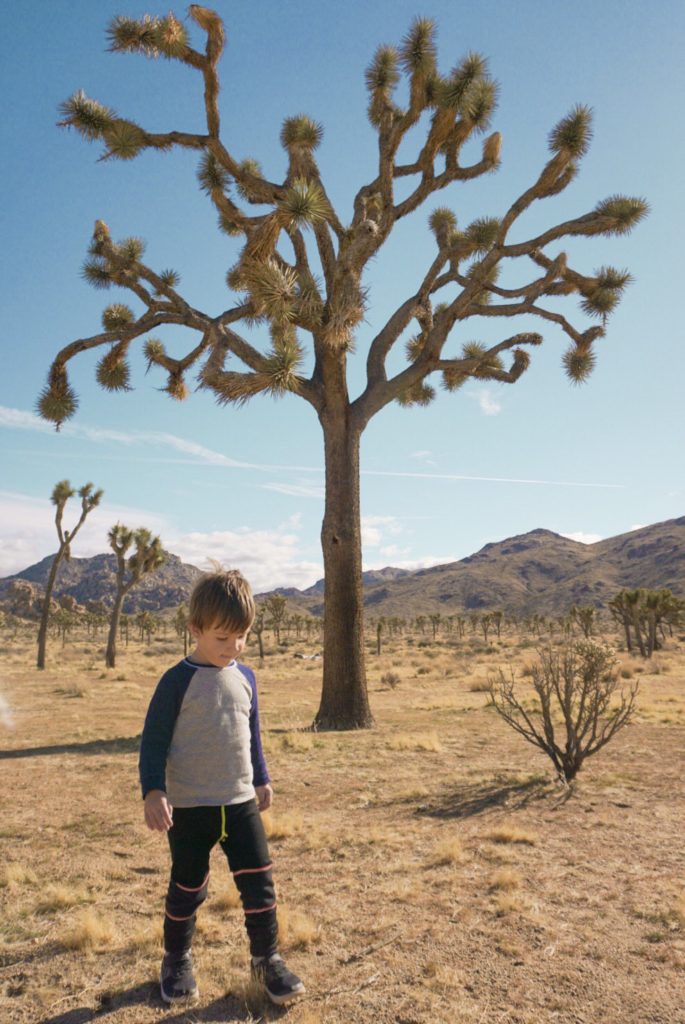
Running free in Joshua Tree National Park is big perk for visiting this park with kids. Photo cred: Laura Gibbons
While Grand Teton National Park is known for it’s rugged mountains and awe-inspiring scenery (and incredible athletes who conquer both!), it’s also my favorite place for families, even with young kids. We are lucky enough to live here with our 5 kids aged 9 and under, but recommend it for anyone, no matter how adventurous you consider yourself! There are an abundance of short hikes that allow incredible views, miles of paved bike paths, quick access to water sports (via the alpine lakes and rivers) and lots of wildlife to keep kids looking.
Also, the town is close so when you need a break or the weather comes in, it’s easy to bail quickly! Our favorite hike is Taggart Lake because the views are incredible, the 5 mile trail is kid-approved and the scenery changes often to keep interest. But, go early in the day or in the Fall to avoid big crowds! Read more tips on visiting Grand Teton National Park and Yellowstone in the Fall.
Find Amelia on her blog, Tales of a Mountain Mama, or follow their outdoor adventures on Instagram.
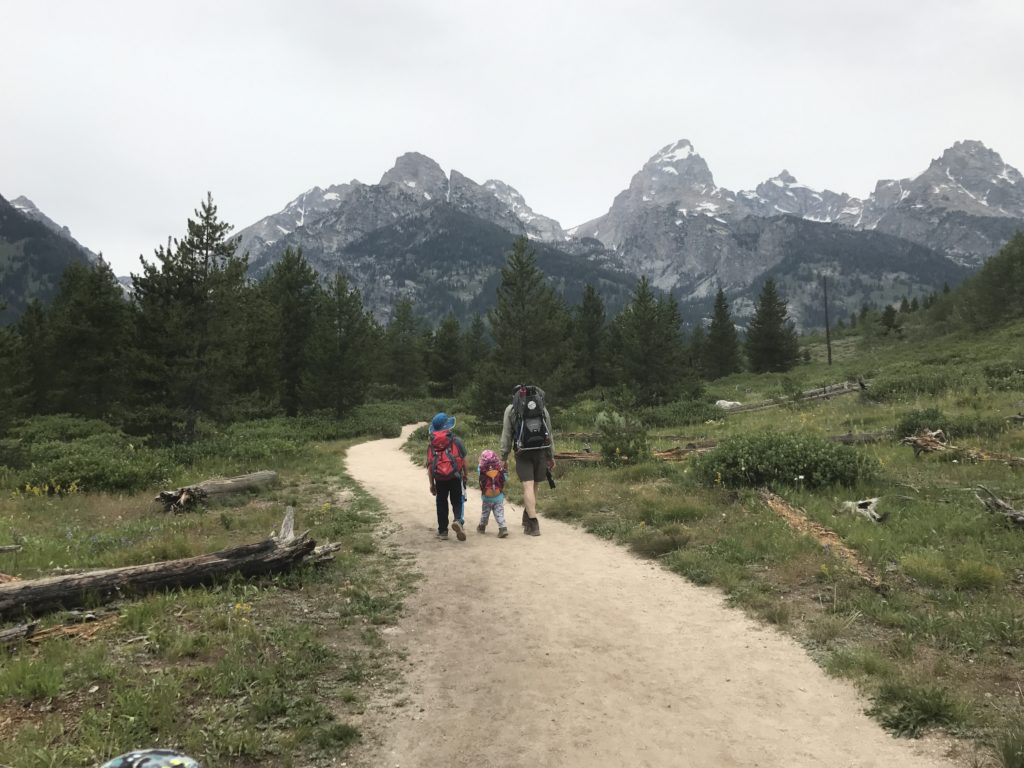
Hiking one of many great trails for kids in Grand Teton National Park, Wyoming. Photo cred: Amelia Mayer
Bryce Canyon National Park is one of our favorite national parks because of its unique geology, its breathtaking vistas, and its fun trails to explore with kids. There is nowhere on Earth like Bryce! Walking among the giant hoodoos on the Navajo-Queens Garden Loop is something out of this world, cooling off at Mossy Cave is a must in the hot summer months, or for a different kind of adventure, horseback riding along the Fairyland trail. You also can’t come to Bryce without catching the sunrise from the Rim Trail (pictured below).
Most people try to avoid the desert in the heat of summer, but Bryce has the advantage of being at above 8,000 feet, so it doesn’t get as sweltering hot as some of the other parks in Utah and Arizona in the summer time. *Tip: Don’t rule out visiting Bryce in the winter months. With the lack of crowds and ability to witness the hoodoos covered in snow, going in Winter is worth the trip!
Read more in-depth details to include best hikes in Bryce, other things to do in Bryce with kids, as well as camping tips in our post, Bryce Canyon National Park with Kids.
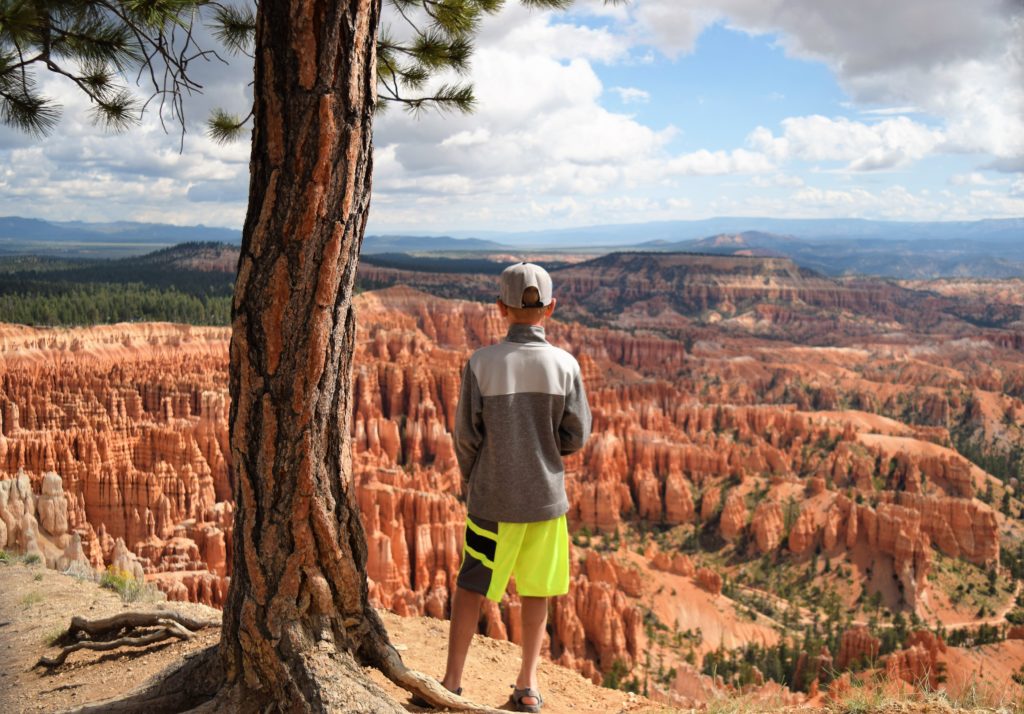
The views from the Rim Trail at Bryce Canyon will leave your jaw on the ground.
The Dry Tortugas are a remote National Park located 60 miles off the coast of Key West. To get there you can charter a boat, take a seaplane, or come over on a ferry. The ferry was the cheapest option for our family of 5 by far ($165 per adult), and since we were already paying to go out, we decided we might as well camp for a few nights while we were there! The small island has beautiful sandy beaches, snorkeling right off the beach along the fort walls and the pier, dark night skies, amazing sunrises, and a historic fort just waiting to be explored. Dry Tortugas has some of the best snorkeling in the United States! There are primitive camping options on Dry Tortugas, but you can also stay in one of many hotels. It was by far one of our favorite family vacations!
Jess Curren and her airstream-living, outdoor-loving family, blog about their adventures and travels at Currently Wandering and can also be found on Instagram. Read more details on their trip to the Hawaiian Volcanoes National Park.
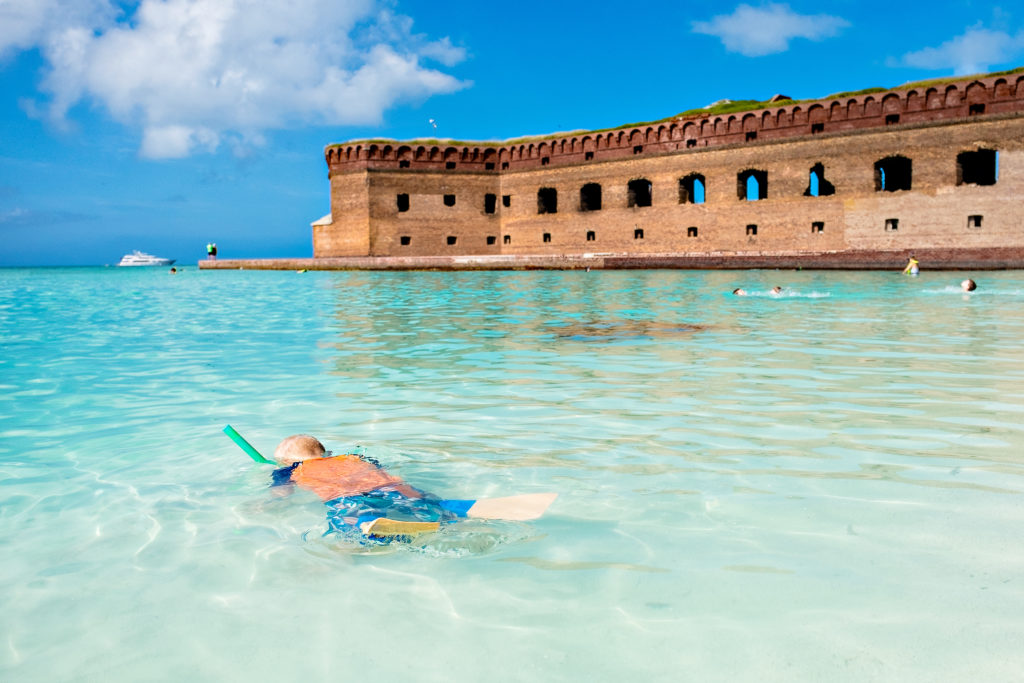
Snorkeling in Dry Tortugas National Park will be a vacation your kids will never forget. Photo cred: Jess Currren
The Great Smoky Mountains National Park offer families endless opportunities for outdoor adventure any time of the year. From family-friendly hikes to playing in streams or just taking in the beauty while driving from Tennessee end to North Carolina, you’ll never be bored here. Our favorite hike and probably the easiest in the entire park is located just behind the Sugarloaf Visitor Center. Bring your bathing suits and let the kids play in the creek to cool off. Laurel Falls is another great hike, although it’s best suited for families with older kids or smaller children in backpack carriers due to the large cliff you walk along at the top.
The journey to the waterfall at the top is well worth it though. As you’re driving through the park be sure to stop at the Newfound Gap for stunning views and a fun photo opp while standing in two states at the same time. Another point to stop at is Clingmans Dome, which is the highest point in the Smoky Mountains. It’s a short but steep hike up, suitable for all ages. Don’t miss the Oconaluftee Visitors Center on the North Carolina end of the park as it’s full of history and the historic buildings are quite fun to walk through.
Brittany Kollmer shares her family travels at October Acres and also runs an online jewelry shop called B Stamped.
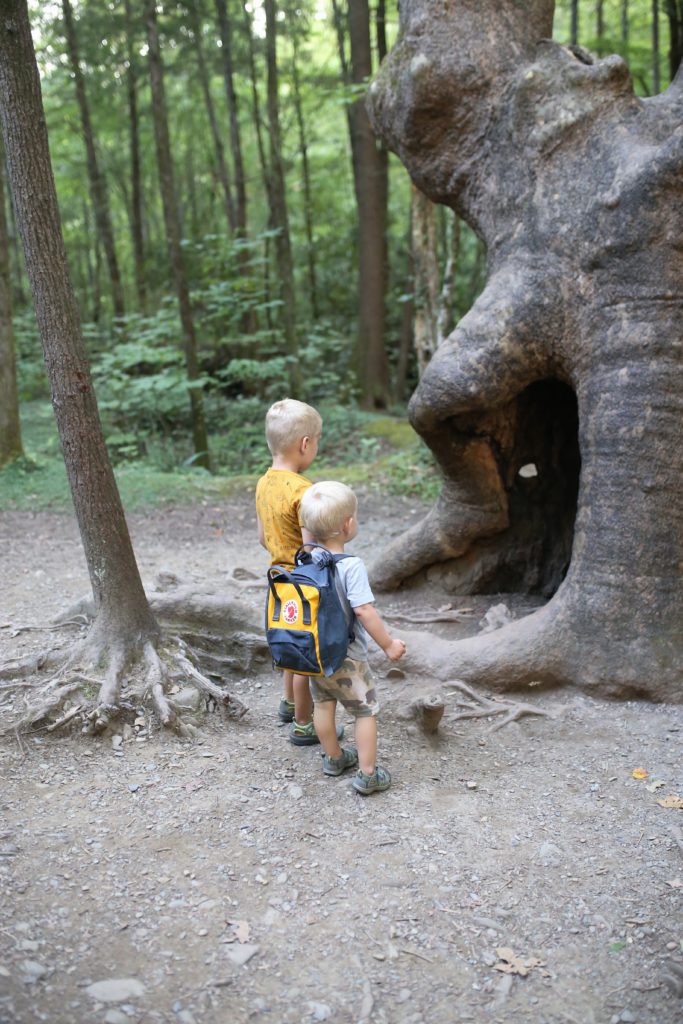
Checking out the cool trees at Smokey Mountain National Park, Tennessee. Photo cred: Brittany Kollmer
Big Bend National Park is our favorite national park that we’ve been too (over the course of a year-long road-trip we’ve been to a lot). The national park, and nearby Big Bend Ranch State Park, offer endless opportunities for kid-friendly outdoor recreation. As part of the Junior Ranger program, kids can earn 3 different supplemental patches for hiking within the park. The intermediate hike takes you to a natural hot spring on the banks of the Rio Grande River. There are lots of other great day hikes within the park. Another junior ranger activity has you discover the night sky. The park rates as a Class 1 location on the Bortle Scale, meaning that it is one of the best places anywhere to stargaze. Finally, just outside of the park in Lajitas, TX, there is a great system of family-friendly mountain bike trails.
Follow Kristen Bonkoski and family at Rascals on the Road as they travel across the U.S. in search of the best singletrack, and also on a mission to get more families on bikes. You can also find all your questions to what kind of bikes and gear to get your family at Rascal Rides.
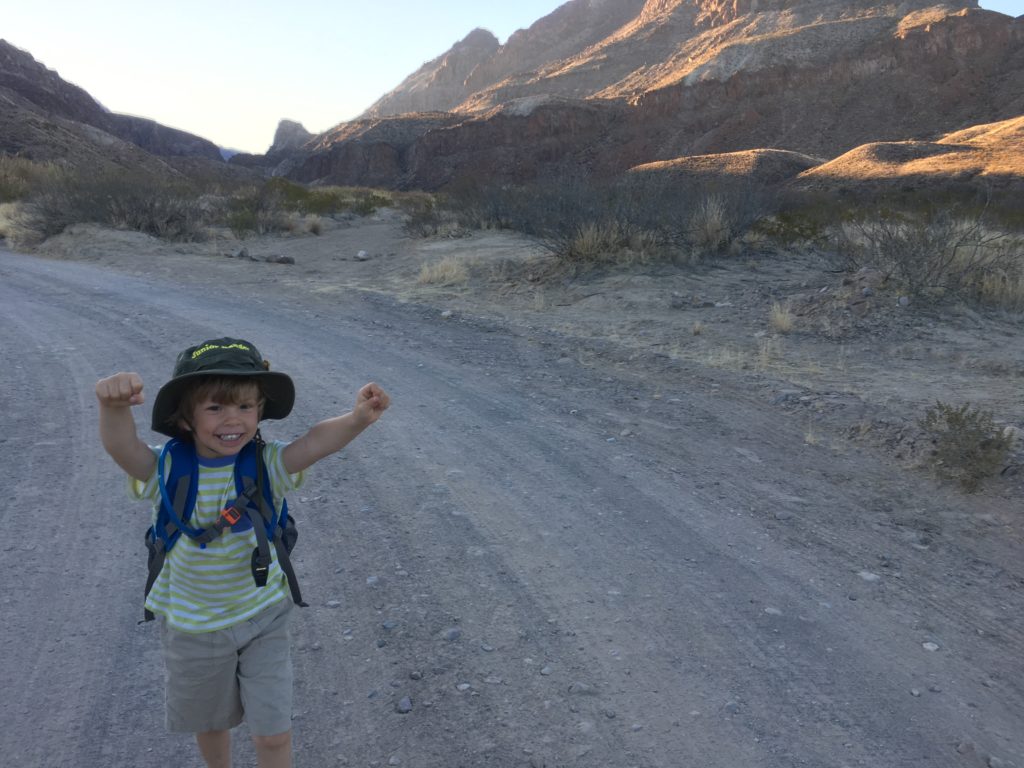
Hiking in Big Bend National Park, Texas. Photo cred: Kristen Bonkoski
A visit to Yosemite National Park is the quintessential family adventure. In Yosemite, you are surrounded in nature, experiencing it all, not just observing it. The beauty of Yosemite extends beyond the natural surroundings in that it offers a wide range of accommodation options, hikes and activities to please all types of families. If there is only one thing you do at Yosemite, it should be traversing the 12 miles of gorgeous bike paths that cross the valley. And if you have little ones, don’t worry, you can rent trailers to pull them along. It is here that you will get away from the crowds so that you can fully experience the land as John Muir once did. And as a bonus, you just might see snakes, bobcats, deer and bears too!
With an abundance of hikes available, its difficult to choose just which one (or 12) to do. For one of the best views, head to Glacier Point (most often closed in the winter months). You can hike here or just take in the vista. Younger kids will love a visit to the Happy Isles Nature Center for a ranger led hike or to just check out their awesome poop exhibit. Lastly, one of the best hikes in the park, in our opinion, is the Mist trail to Vernal Falls, an uphill hike with a cool payoff. Whether you camp, stay in tent cabins or in a hotel, spending time in Yosemite will provide you ample opportunities to replenish, refresh and rejuvenate.
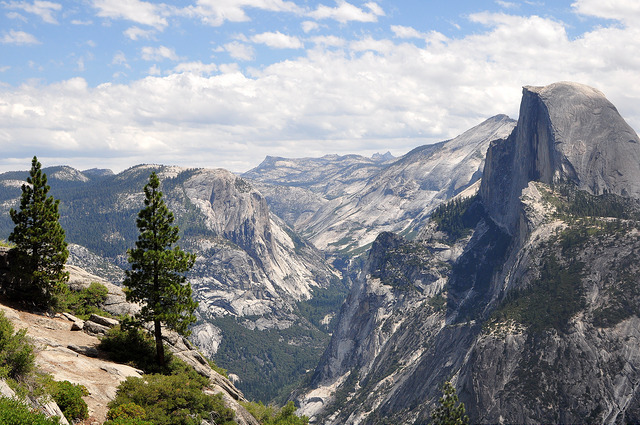
The view of Half Dome from Glacier Point in Yosemite National Park is truly memorizing. Photo cred: Karilyn Owen
Karilyn Owen is a family travel blogger at No Back Home, residing in California and traveling with her son all over the world as often as they can. You can also find them on Instagram and get more Yosemite recommendations on their Ultimate Guide to Yosemite.
Thanksgiving spent at the Grand Canyon is our family tradition. This tradition began when our sons were in grade school and I was tired of cooking and we wanted to make special memories together over the holiday. In our opinion, each visit to Grand Canyon National Park is special, unique and never disappoints. Seeing the Canyon for the the first time will take your breath away no matter how old you are and no matter how many photos you’ve seen.
The Canyon is mesmerizing. We enjoy hiking along the paved Rim trail on the South Rim (the North Rim is closed in winter) or on the famous trails below the rim such as Bright Angel and South Kaibab. When our sons were 11 and 13, we backpacked to Phantom Ranch at the bottom of the Grand Canyon. Starting out at the top, the weather was cold and the leaves had fallen from the trees. By the time we hiked to the bottom, losing nearly 5,000 vertical feet over 6.3 miles, we’d traveled back in the seasons to late summer, with warm temperatures and green leaves clinging to the Cottonwood trees.
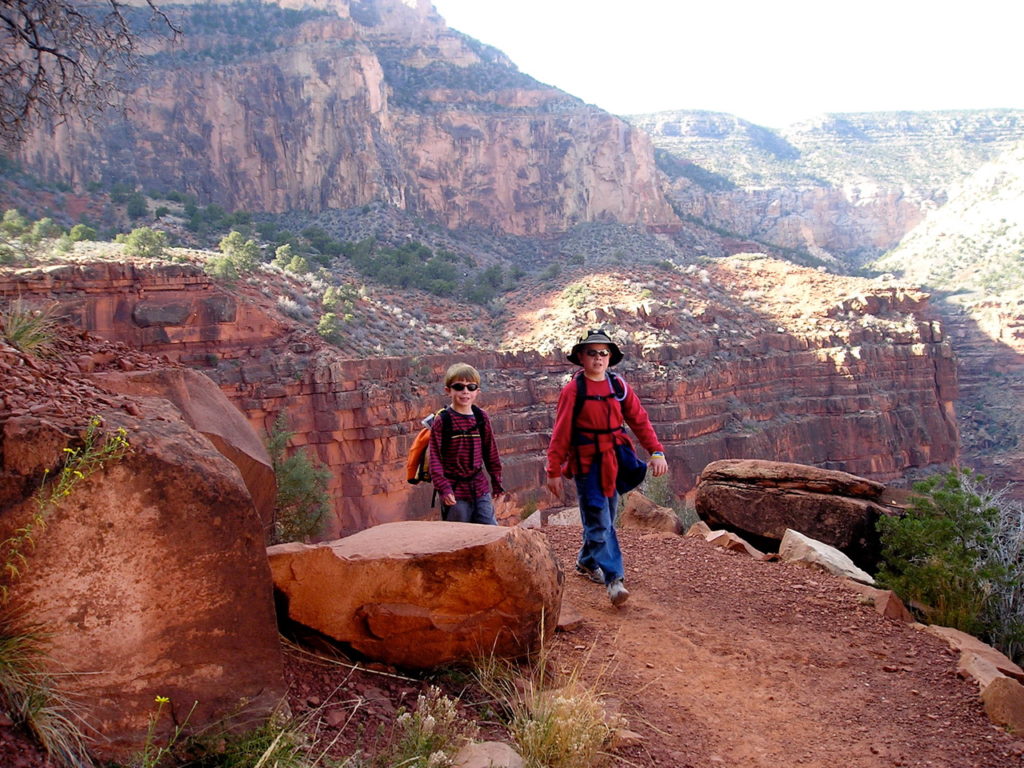
Hiking one of the Rim trails at Grand Canyon National Park. Photo cred: Kristen Lummis
Kristen Lummis is blogger for Brave Ski Mom and freelance writer based in Colorado, where she writes about family skiing, outdoor adventure and healthy living. Read more about their Fall hiking adventure to the Grand Canyon.
Did you know that Everglades National Park in Florida is the largest subtropical wilderness in the U.S.? It is also home to the endangered manatee, Florida panther and American crocodile. The Everglades is also a World Heritage site. For families, it is a great national park to learn about and spot all the different species of wildlife here, and there are also a variety of activities fitting for children, such as taking a swamp boat tour or kayaking through the mangrove trees of the swamp.
If you are really up an adventure, you can canoe or kayak the Wilderness Waterway, which is 99 miles long and takes approximately 7-10 days to complete. There are also ample bike trails to explore in the park, and if you love hiking and camping, you won’t get bored in the Everglades. Fishing is also a popular activity in this national park (keep in mind there is limited shoreline fishing here), and you can even charter a fishing guide for a day if you really want to experience fishing at its finest within the park.
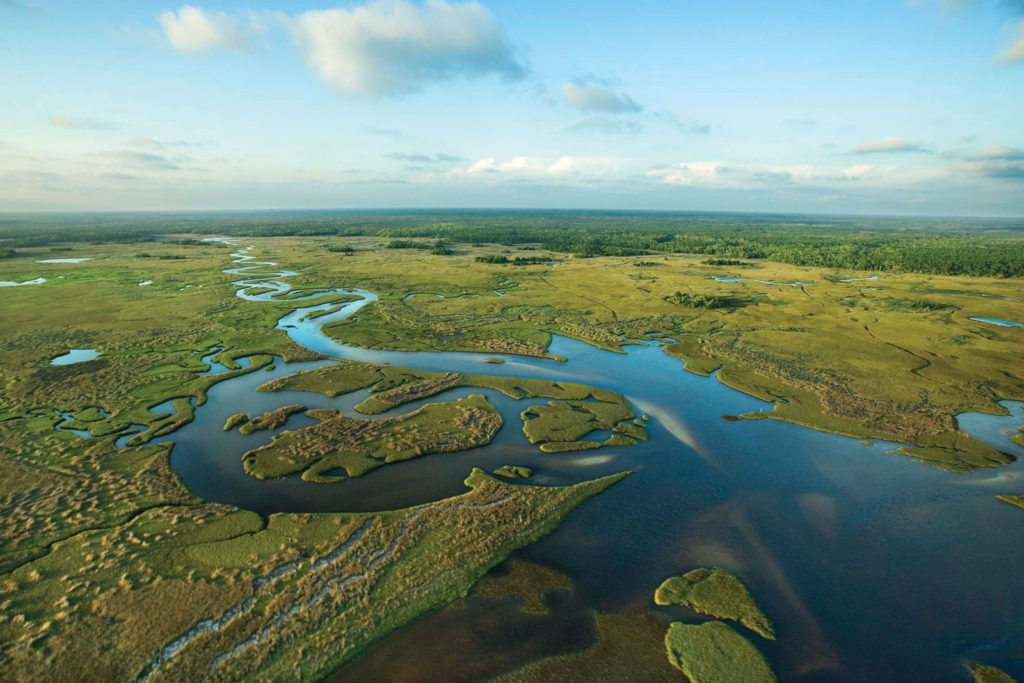
The Everglades National Park is vast and diverse with abundant wildlife. Photo courtesy of Brittanica.
Glacier National Park is one of the most amazing national parks to take your kids. The views alone will take everyone’s breath away and driving along the infamous Going To The Sun Road will never be forgotten. On top of that it is home to some of the best hikes we have ever done as a family. Our favorite trails in Glacier include hiking to unbelievable lakes such as Avalanche Lake and Hidden Lake and crystal clear, beautiful waterfalls such as St Mary Falls and Virginia Falls.
One bucketlist hike you have to do is the Grinnell Glacier trail. Add river rafting and animal sightings (we saw multiple bears and a moose) and you have the perfect outdoor adventure vacation for you and your family! There is never a shortage of things to do in Glacier.
Bryanna Royal is the founder of Crazy Family Adventure, where they blog about their full-time travels and outdoor adventures in a RV across North America.
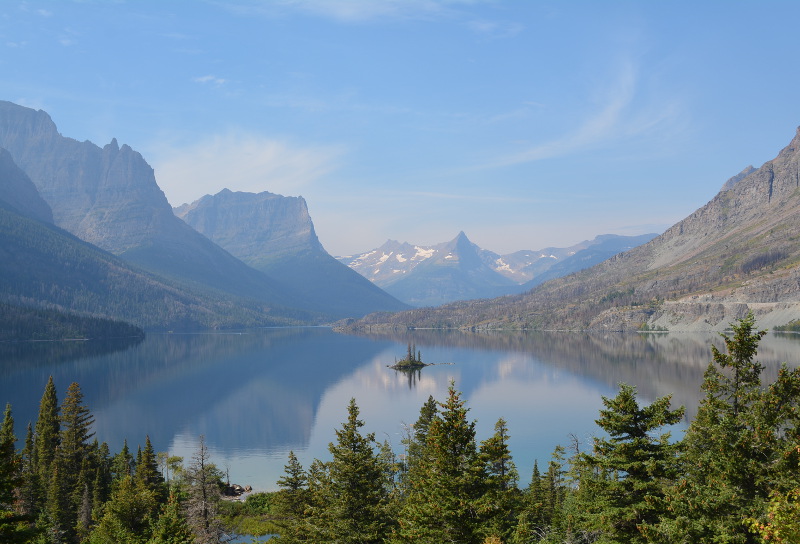
The iconic view of St. Mary’s Lake in Glacier National Park, Montana. Photo cred: Bryanna Royal
The Olympic National Park in Washington is one of the U.S.’s most diverse national parks. Only here can you visit a rain forest, glacier mountain peaks and beach all in the same day. When you visit, you can’t miss the famous Hoh Rainforest, the largest rain forest in the contiguous U.S. We loved walking the Hall the Mosses and the Hoh River trail. You will never see so much moss in your life!
Make sure to take a drive to the top of Hurricane Ridge where you can witness some stunning vistas of the surrounding mountain peaks, spot some deer, and take in a hike on one of the hiking trails in the area. The Sol Duc Valley is a stunning valley with waterfalls (such as Sol Duc Falls) and hot springs.
Probably the area of the Olympic National Park that we loved most was all the beaches along the west coast. Endless tide pools to explore and protected marine sanctuaries reside along this rugged coastline, and getting to them is half of the adventure! The hikes are short and beautiful to beaches such as Ruby Beach, First Beach and Second Beach. Also, if you’re up to a longer hike, the trail to Shi Shi Beach and the Point of the Arches will not disappoint!
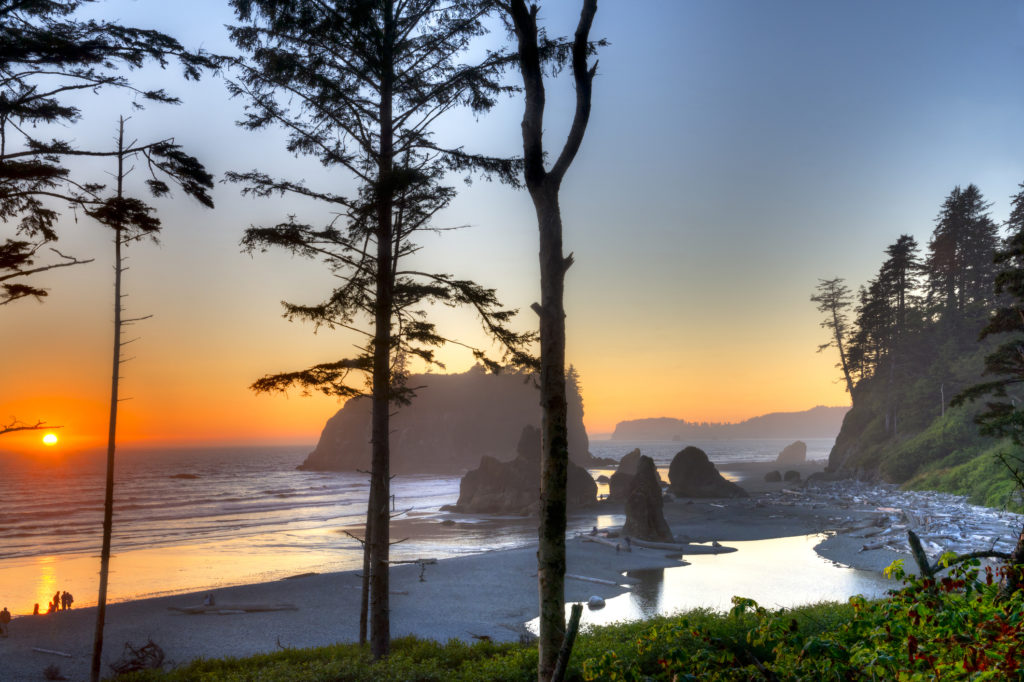
Sunset at Ruby Beach in the Olympic National Park, Washington
There’s something about being 6,700 feet up in the High Sierras of Sequoia National Park that lifts our family’s soul up, reminding us of just how grateful we are to have what we have and to do what we do, evolving and growing and mastering our awareness. Walking the land that John Muir fought so passionately to preserve so that future generations can breathe in the depth of its wild air is special and Muir’s voice resonates in our minds and propels us forward in our stewardship. “Climb the mountains and get their good tidings. Nature’s peace will flow into you as sunshine into trees. The wind will blow their own freshness into you, and the storms their energy, while cares will drop off like autumn leaves,” he said and we do.
In Sequoia National Park, you can’t miss exploring the groves of giant Sequoia trees, climbing Moro Rock, or visiting Crystal Cave which is a must with kids. If you are into hiking, there are lots of great hiking trails throughout the park and even in the backcountry.
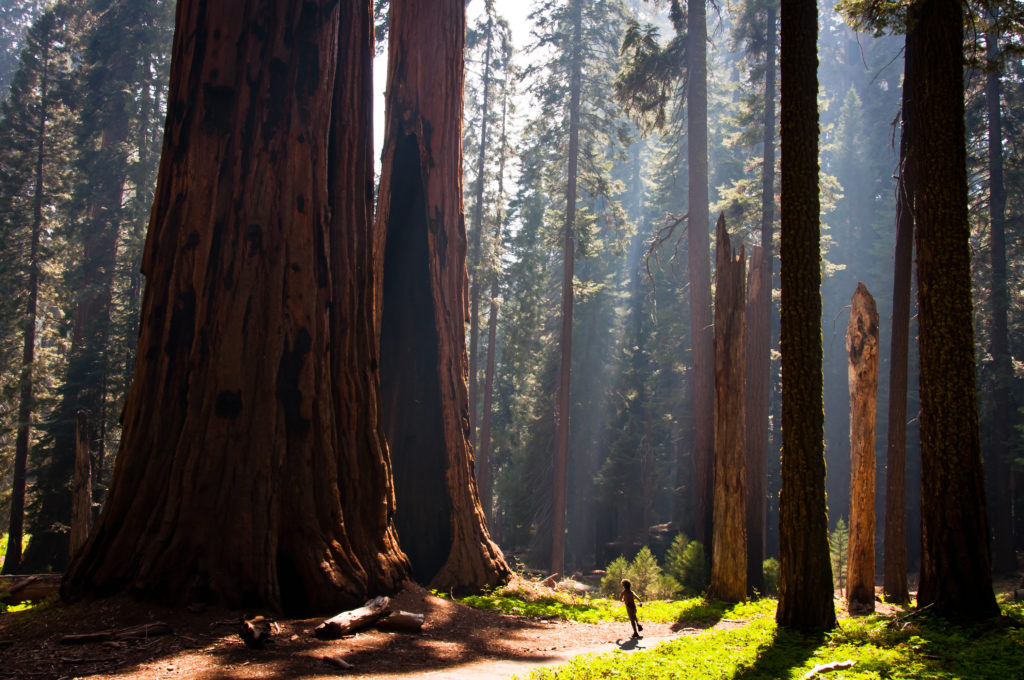
Sequoia National Park basking in its glory. Photo cred: Kerem Hanci
Jennifer Fontaine is a health, wellness, and family travel expert and founder and managing editor of Outdoor Families Magazine.
And that rounds up 25 of the best national parks to visit with kids. Is your favorite national park on this list? If not, what is your favorite national park and why?
For some reason I never got round to writing up our thoughts and adventures for 2021’s 30 Days Wild, we must have been too busy with life the universe and everything. But you can still see and enjoy the list of activities we did for this year.
I can’t believe 30 days wild is over already! We always have so many great adventures, experiences and memorable encounters with wildlife during 30 days Wild. Each day in June we try to connect with nature in different ways by exploring new places, making, baking, cooking and learning more about wildlife and the natural world around us as we go along.
This year we got caught in a thunderstorm and danced in the rain, gently held butterflies and moths, shrieked with excitement at scuttling crabs, climbed trees and built dens, went pond dipping, looked for wildflowers, helped with citizen science projects, made homes for wildlife, experimented with botanical dyes, joined in with the Big Wild Weekend camp out and quietly watched hedgehogs moving round our garden at night.
One of our favourite highlights this year was spotting two new species of bee to add to the record of wildlife found at Peartree Green Local nature reserve. We spotted the “Silvery Leafcutter bee (top) and the Large Scissor Bee (bottom) whilst we were taking part in The Great British Wildflower hunt.
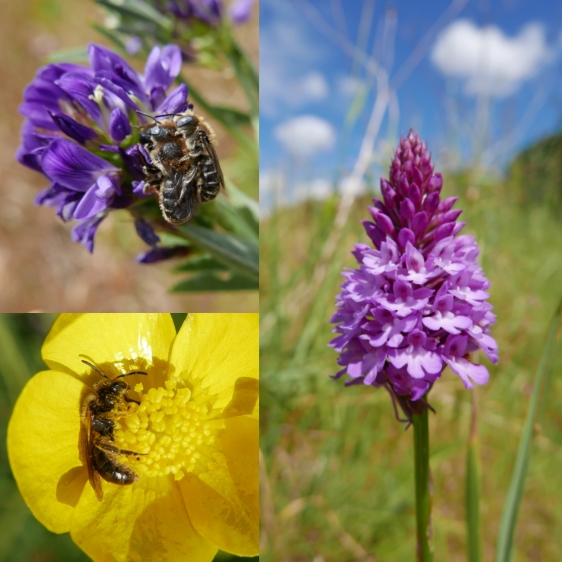
Being on lock down during the pandemic has really made me appreciate the importance of green and natural spaces in our lives. Being able to connect with nature is so important for our physical and mental wellbeing and many studies have shown that spending time outdoors in nature helps lower levels of anxiety, stress and depression in both adults and children.
We are so incredibly lucky to have so many wonderful wild spaces on our doorstep, even though we live in a very built up urban area. During 30 days wild we were able to enjoy visiting and exploring several nature reserves, woodlands, meadows, country parks, ponds, lakes, rivers, streams, a farm and parts of the shore. My sons both loved running wild, climbing, laughing and looking for wildlife along the way.
The only reason we have these beautiful spaces is because they have been protected and cared for future generations to enjoy. They are little pockets of wilderness, beauty and wildlife in an otherwise urban jungle. Its more vital than ever to protect these special places not only for the benefit of our own physical and metal wellbeing but also for the incredible wildlife that thrives in these areas.
As wildlife habitats are in decline it’s more important than ever to make space for wildlife. Not only in nature reserves and parks but also in our gardens or around our homes. Making a home for wildlife in our garden has already greatly increased the amount and diversity of wildlife in our garden, we can easily see the benefits and difference the small changes we made last year have made, We now have a whole wealth of beautiful pollinating bees, butterflies, beetles, moths and even hedgehogs, slow worms and frog visiting and living in our garden.
If everyone made small changes to their gardens and homes we could greatly increase the chances of survival for many endangered and important species of wildlife. Even by simply letting areas of grass grow long and wild in your garden or by letting ‘weeds’ grow. ‘Weeds’ are really just successful wildflowers and plants and many people don’t realise what a vital source of food, shelter and egg laying spaces they provide for many pollinators and species of insect,
For example Dandelions are beautiful wildflowers that provide an important source of food for pollinators. They flower early in the year long before any other plants. Bees, butterflies, and many other insects feed on the pollen and nectar, and caterpillars of butterflies and moths feed on the plants. Did you know in Up until the 1800’s it was actually common for people to pull up grass in their garden to make room for edible flowers like dandelions.
One of the benefits of lock down was being able to see the verges and edges of roadsides and pathways grow wild and bloom with beautiful wildflowers. They were like mini meadows buzzing with busy insects… until normality resumed and the councils cut them down into ugly patches of dead dried grass. It was a stark contrast and a reminder that our cultural and social obsession with tidiness and neatness also has a needless detrimental impact on the wildlife around us. Why can’t we enjoy grass as grass is meant to be beautiful long, blooming with wildflowers and buzzing with insects.
This year I was also devastated to see one of our local nature reserves choking and covered with plastic! It heart breaking hearing my sons little welly boots crunching on tiny little plastic nurdles that coated the ground, they were everywhere along the shoreline stretching as far as the eye could see. On top of this was fly tipped rubbish and everyday litter, with bottles and plastic bags and packaging all across the reserve.
It’s made me realise the reality of the growing threat of plastic pollution to our environment. It’s also made me realise we have to start changing the way we think about and use plastics in our daily lives. If we all reduced the use of plastic in our daily lives we would greatly decrease the amount of plastic pollution in the environment.
Single use plastics are one of the biggest contributors to plastic pollution. By switching to environmentally alternatives you can avoid them entirely. For example using bamboo toothbrushes or cutlery rather than plastic ones, by wrapping food in beeswax wraps rather than clingfilm or by making your own bath and beauty products.
There are so many things you can do to help nature, from making your garden more wildlife friendly, litter picking, getting involved in conservation and going plastic free, to volunteering at local nature reserves, supporting wildlife charities , donating money and petitioning on behalf of environmental causes.
But the most important thing you can do is share your passion and enthusiasm for it, show pictures, share stories, educate and encourage others to join in with you. We protect the things we care about, and in order to get society to care about nature we first have to get them to engage with it.
30 days wild for me personally is very much about encouraging others to enjoy and care about nature, it’s about raising awareness and passing on knowledge, promoting conservation and supporting our local nature reserves and wildlife charities, not just for 30 days wild but as something we embrace as part of our daily lives all year round.
You can find our full list of 30 days wild activities below. There are lots of easy, fun and simple ideas that we hope you might enjoy trying yourselves:
Dandelion vegan honey and caffeine free dandelion root coffee
Making birds nests, feather quill pens and an egg-citing experiment
Strawberry picking + homemade strawberry ice cream and strawberry gin.
The Big Wild Weekend Summer solstice camp out and mini beast hunt
Nasturtium and Lavender flower biscuits and Rosemary cupcakes
30 days wild is a something we look forward to every year. We have so many wonderful moments together and unforgettable experiences. Our favourite parts are always the memorable close encounters with wildlife.
This year was no exception, the look of wonder and joy on my son’s face as he held baby hedgehogs at a hedgehog shelter, released butterflies that we had raised from caterpillars, stroked a snake and walked an Argegentian Tegu Lizard lizard called Salvador was priceless.
We are lucky to have so many wonderful places near us to explore. Over the 30 days wild we visited several nature reserves, woodlands, meadows, country parks, farms, ponds, lakes, rivers, streams and parts of the shore. My son loved running wild, climbing, laughing and looking for wildlife along the way.
On the shore we found a giant jellyfish, gobi fish and a variety of seashells. We laughed at scuttling crabs and marvelled at a translucent little shrimp whilst crabbing on a tidal river.
We also carefully held different types of insects, listened to birdsong, smelt wild flowers, felt the grass between our toes, found egg shells from newly hatched birds, and picked and ate fresh strawberries, peas and beans.
We always learn and disover new things as we go along. This year we did some simple science experiments, growing different types of seeds, measuring rainfall, creating spore prints making a wormery and taking part in a Citizen science project on Soil invertebrates.
We also volunteered our time and took park in nature conservation activities helping with a Bioblitz (an ecological survey) where we found newts and insects, litter picking, planting an oak tree, sowing wildflower seeds and making a wildlife pond.
On rainy days (there were a lot of those this year) we splashed in puddles, looked out for snails and baked biscuits flavoured with flowers and herbs from the garden.
We also used herbs, flowers and plants in the garden to make natural playdough, wildflower seed paper, candied rose petals, nature imprints, tree spirits and nature art frames.
Every year we also find a heart shaped stone from the shore as a memento of our adventures and activities.
For me 30 days wild is also very much about encouraging others to enjoy and care about nature, it’s about raising awareness and passing on knowledge, promoting conservation and supporting our local nature reserves and wildlife charities, not just for 30 days wild but as something we embrace as part of our daily lives all year round.
I want my children to grow up to enjoy and appreciate nature, to be inquisitive, curious and care about the world around them.
There are so many things you can do to help nature, from making your garden more wildlife friendly to litter picking, getting involved in conservation, going plastic free, petitioning the government, donating money or volunteering to help wildlife charities and nature reserves.
But the most important thing you can do is share your passion and enthusiasm for it, show pictures, share stories, educate and encourage others to join in with you.
We protect the things we care about, and in order to get society to care about nature we first have to get them to engage with it.
Everyone takes away something different away from their connection with nature.
For my five year old son it’s the joy of splashing through streams and puddles, climbing trees and running wild exploring.
For me it’s the general sense of well being and happiness I get just from being outside and close to nature. The enjoyment of finding or learning something new and the pleasure of nature photography.
Although 30 days wild is over we will continue to stay wild and hopefully have many more adventures throughout the year.
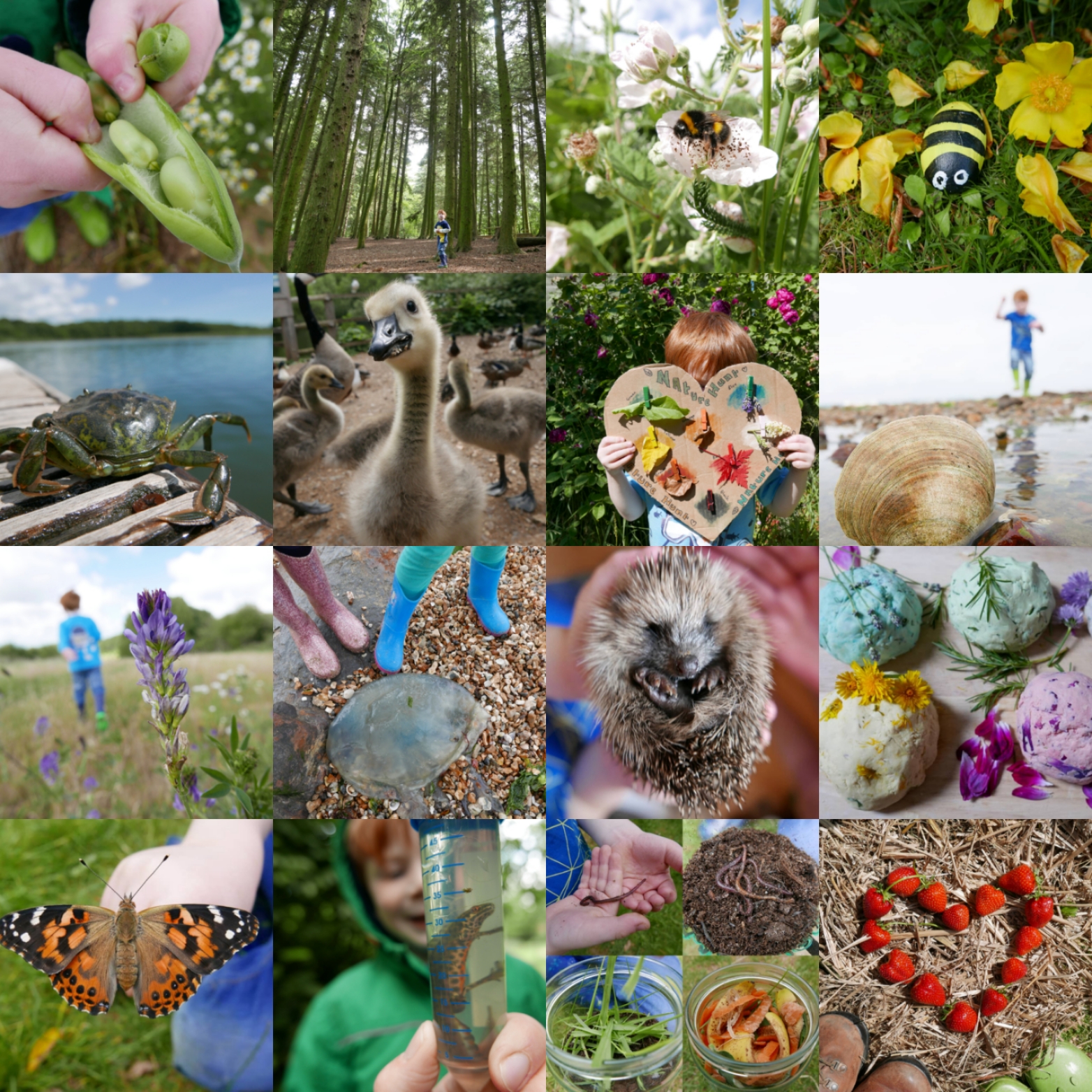
For nature activity ideas to try yourselves please see the list below of everything we did for this years 30 days wild:
Visited a hedgehog rescue and held baby hedgehogs, identified shells and balenced rocks on the shore.
Planted an oak tree and started some seed growing experiments.
Made a wormery and took part in a Citizen science project on soil invertebrates.
Made naturally scented and coloured playdough using herbs and flowers from the garden.
Picked broad beans and looked for ladybirds amongst the wild daisy’s.
Made welly boot plant pots and sowed wildflower seeds in the garden.
Pond dipping and woodland adventures with friends at Swanwick lakes nature reserve.
Released and held some painted lady butterflies that we had raised from caterpillars.
Explored the shore, spotted butterflies in a wildflower meadow and made a stick rattle.
Spore printing from mushrooms and looking at the insects we caught in our tumble traps.
Tree spirits, wildflower seed bombs and nature imprints from clay.
Painted rocks to hide, explored a woodland stream and entered a gardening competition.
We really enjoyed taking part in the 30 Days Wild challenge again this year, there was a lot of fun to be had enjoying the outdoors and wonderful wildlife as well as making, baking, exploring and learning along the way.
Somehow (despite the addition of a newborn this year) we managed to do 30+ activities and random acts of wildness over the 30 days.
It was a great motivation to get out and about with my 4 year old son (with his baby brother in tow), spending quality time together talking, laughing and playing.
We ran through wildflower meadows and farm fields, picked and ate fresh fruit, climbed trees, splashed in woodland streams, found jellyfish on the shore and caught crabs from a pontoon.
Our favourite part of 30 days wild is always the unexpected wildlife encounters. This year did not disappoint! There was an exciting moment when a female roe deer burst across the meadow we were in, an adorable procession of fluffy baby swans and our very first live Stag Beetle encounter.
We also got to see and hold all manner of minibeasts when we spent time exploring three of our local nature reserves. We helped with a Biobblitz survey at Peartree green nature reserve where we had a lovely encounter with a snail and found an interesting assortment of insects.
At Swanwick Lakes we celebrated their 25th anniversary and enjoyed the family day activities, pond dipping and sweeping nets through the meadow to catch crickets, grasshoppers and beetles.
At Millers Pond Nature Reserve we litter picked together as part of the Conservation work day and enjoyed Sholing Valleys Study Centres Nature tots session. I also went round on another day taking habitat reference photos and was lucky enough to get close to a dragonfly munching nosily on a bumble bee.
On days when we couldn’t go further afield. We had fun exploring nature at home or encouraging wildlife in the garden. We made slowworm and hedgehog shelters, insect houses and bird feeder bunting as well as creating wildflower seeds bombs, natural perfume and sun catchers.
On other days we used the fruit and herbs we had picked to bake rosemary biscuits and make milkshakes, strawberry jam, fruit ice lollies and a rhubarb crumble (which unfortunately got cremated when I forgot to turn the over timer on).
We always talk about what we are doing so we learn and share as we go.
As my son gets older his understanding of the world is growing and we are able to explore things in more depth. This year we did an experiment to demonstrate decomposition to him so he could understand the role insects, weather and time play in breaking things down. It also demonstrated that man made materials don’t decay in the same way/or at all, which gave us the opportunity to talk about why littering and man made materials are bad for the environment.
This year we were also pleased to be picked by Bear Nibbles to take part in four additional weekly challenges. They sent us a wonderful pack full of activity cards, wildflower and bird seeds, a bamboo straw, and Bear Nibbles goodies and snacks to keep us going on our adventures. For week one we championed ‘Sustainability and conservation’, week two was ‘Getting wild in the urbanscape’, week three was ‘Exploring our local nature centres’ and week 4 was ‘Wild crafting’.
Some of the activities we started for 30 Days Wild are ongoing. We are watching and waiting as some caterpillars transform into beautiful red cinnabar moths, Our giant sunflower is growing taller by the day and our Triops are merrily swimming round their tank.
We plan to stay wild and enjoy exploring nature and the wild world around us throughout the year until its time to start thinking up fun things to do for next years 30 days wild.
I highly recommend taking part yourselves (if you haven’t been already) its fun, free and you will be surprised at all the things you discover along the way, new places to explore, simple activities to enjoy, wonderful wildlife and hopefully lots of memories and adventures of your own in the making.
Here is the list of all 30 activities for inspiration and ideas for your own adventures.
1. Made a slowworm shelter in the garden.
2. Explored the shore and found jellyfish, crabs and winkles. We also visited a local pond and saw some baby swans.
3. Catching crabs and tree climbing.
4. Making cress seed caterpillars.
5. Homemade natural perfume.
6. Sunprint nature shapes on photographic paper
7. Baked rosemary biscuits and went on a wild walk
8. We set up an antarium to observe ants and made banana milkshakes
9. Went to the National Oceanography centre open day and picked strawberries and peas
10. We painted rocks to hide for others to find.
11. We grew a mushroom and made bird feeder bunting and a footprint tracker
12. We made strawberry ice lollies and a hedgehog house.
13. Learning about decomposition and making an insect house we also encountered a Stag beetle.
14. Exploring a woodland park and feeding the ducks.
15. We made ice decorations and went strawberry picking
16 We helped with a Bioblitz at Peartree nature reserve
17. We celebrated Swanwick Lakes 25th birthday and enjoyed the family day activities
18. We sowed some wildflower seeds and supported our local nature reserves
19. We made strawberry jam, took habitat reference photos and spotted a dragonfly
20. We made wildflower seed bombs
21. We picked Rhubarb and ran wild in the fields, meadow and on the shore.
22. We enjoyed flowers and tried to help out the bees
23. Raising caterpillars and looking for minibeasts
24. Litterpicking, nature watch and making tree spirits
25. We made sun catchers and checked on our caterpillars
26. Raising Triops
27. We went on a rainbow nature hunt and made cloud binoculars
28. Den building and a teddy bears tea party
29. We played nature games
30. We picked blackberries and spotted butterflies
My little boy and I really enjoyed taking part in The Wildlife Trusts 30 Days Wild challenge 2017, it gave us the opportunity and excuse to explore new places and try new things.
Some days we went on adventures with friends and discovered fun local places – all of which we plan on visiting again in future – playing hide and seek in woodlands, crabbing and balancing rocks on shores, picking our own fruit and vegetables, running through fields and splashing through streams and puddles.
Other days we did random acts of wildness at home, encouraging and helping the wildlife in our garden by planting wildflower seeds and making shelters and feeders or playing nature games, going on bug hunts or making pictures and paints from natural things we found in the garden.
We learnt a lot by talking about the things we saw and did as we went along, for example looking at tadpoles and talking about the life cycles of frogs and collecting different types of seeds and nuts and talking about what animals eat them and how plants grow. On rainy days we puddle splashed, measured rainwater and talked about the weather and water cycle.
Some of the things we tried didn’t always go to plan, our small animal tracker and bird feeders kept getting sabotaged by a cheeky squirrel, but we still had fun making and monitoring them.
Our first attempt at crabbing also wasn’t very successful as we went at the wrong time of day when the tide was high and the crabs were well fed, but we enjoyed exploring the shore instead and went back the next day with friends to try again.
The second time we caught lots of crabs very easily, both big and small the children were fascinated. They shrieked and laughed as they scuttled past them when we let them go. There was also a lot of excitement when we accidentally caught a fish on the crab line, the looks on their faces were priceless as they looked at the fish before we safely returned it to the water.
One of my favourite activities was volunteering at our local nature reserve. Sholing Valleys is an area of meadow, woodland and pond preserved and cared for by volunteers. Every last Sunday of the month they have a volunteers day where anyone can help out.
My little boy was a bit too young for going out in the boat to clear the pond or cutting back the foliage on the paths. So instead we went around the meadow together litter picking and counting butterflies. He loved proudly using the litter picking stick to grab things and put them in the bag all by himself and we talked about looking after the environment and how bad rubbish is for wildlife.
When we went to see how the group by the pond was doing and one of the ladies spotted some movement on the path which turned out to be a confused baby shrew. Seeing such a tiny baby shrew up close was a first for us both and a wonderful moment to share with my little boy that I will remember for a long time.
We really enjoyed the volunteering day and are looking forward to helping out again in future. We have also signed up to join the bat walk they are running in August so we can learn all about our local bats and hopefully see and listen to a few.
Our best moments from 30 days wild were definitely the unexpected ones from giggling at tickly ladybirds on our hands to finding heart shaped stones, getting excited over tiny tadpole legs and accidentally catching a fish, these are moments and memories we only got from venturing outdoors and taking time to explore and enjoy the nature around us.
Even if it is only as far as your garden or street there is a whole mini amazing ever changing world going on around us. Come rain or shine, winter or summer there are plenty of easy and free wild things you can try and do yourselves.
For inspiration and ideas check out our Inspired by 30 Days Wild activity ideas guide or see the full list of all 30 wild activities we did below.
Here is the full list of our 30 days wild activities and nature finds:
1. Collected flowers from the garden to talk about, press and preserve.
2. We made a wormery and we also found a worm, slowworm, and dung beetle in the garden.
3. Played a colour nature hunt game and we found a red cardinal beetle.
4. Released butterflies we had watched grow from caterpillars and found banded and garden snails to compare and talk about
6. Planted bee friendly wildflower seeds
7. Broadbean picking and we found ladybirds and ladybird larvae.
8. Picked different herbs to touch, taste, smell and talk about
9. Played a Nature Bingo/finding game in the garden
10. Joined the Butterfly Conservation Society and collected natural objects to make nature art.
11. Made colourful nature paints from flowers, fruit and plants.
13. Made a small animal foot print tracker.
14. Found some woodlice and picked strawberries to draw and eat.
15. Tried crabbing and didn’t catch anything so we explored instead and counted squirrels.
16. Crabbing successfully this time, also accidently caught a fish (we let it go)
17. Took apart a rose and talked about flowers and pollination.
18. Talked about spiders and made a spider web catcher.
19. Made a butterfly shelter.
20. Made a ladybird house
21. Looked at tadpoles and talked about the life cycle of a frog.
22. Pond dipping and talking about pong plants and wildlife.
23. Collecting different types of seeds to look and talk about.
24. Rock balancing on the shore.
25. Bug hunt in the garden and we found Rose sawfly larvae on the rose leaves.
27. We made a rain measure and talked about the water cycle.
28. We made a weather monitor and a wind sock and talked about the different types of weather.
29. Blackberry, strawberry, pea and courgette picking as well as finding and holding ladybirds.
30. We found a speckled bush cricket and took part in the big butterfly count.
This is a FAQ description. Add more detail about this service, such as benefits, appearance, components and value
This is a FAQ description. Add more detail about this service, such as benefits, appearance, components and value
This is a FAQ description. Add more detail about this service, such as benefits, appearance, components and value
This is a FAQ description. Add more detail about this service, such as benefits, appearance, components and value